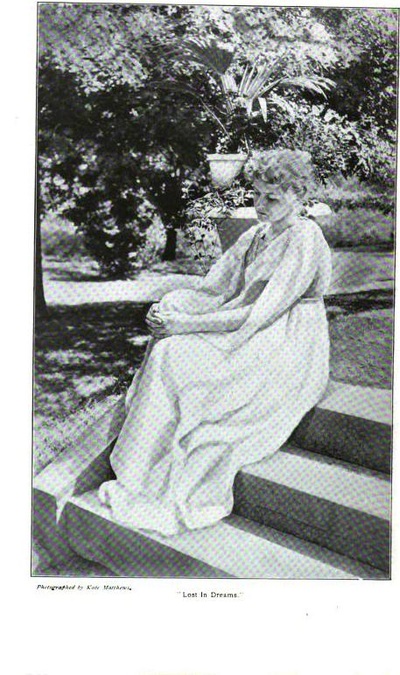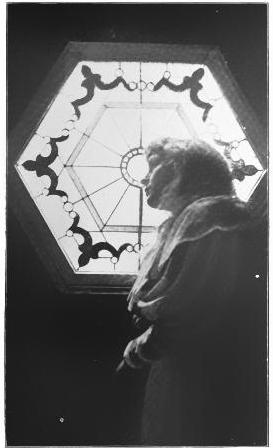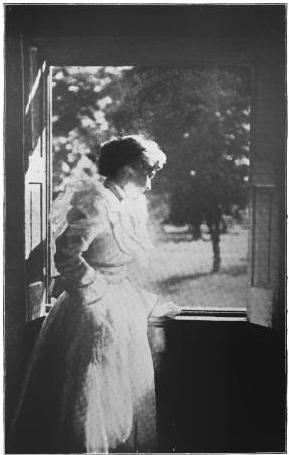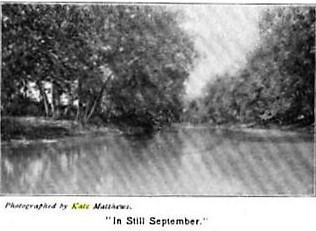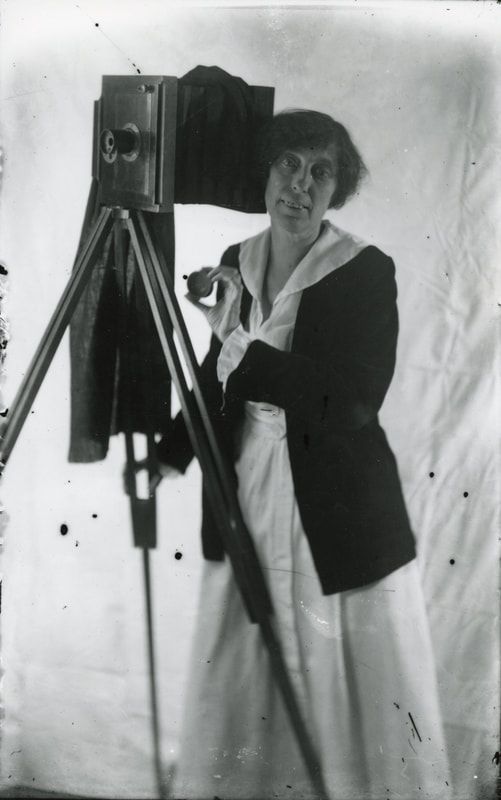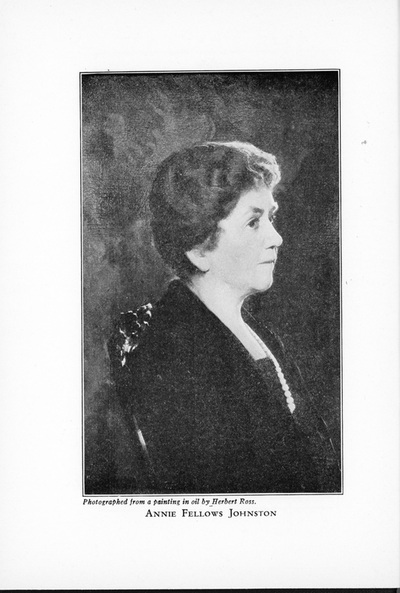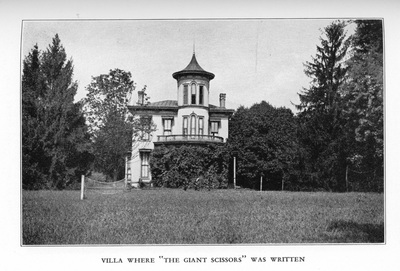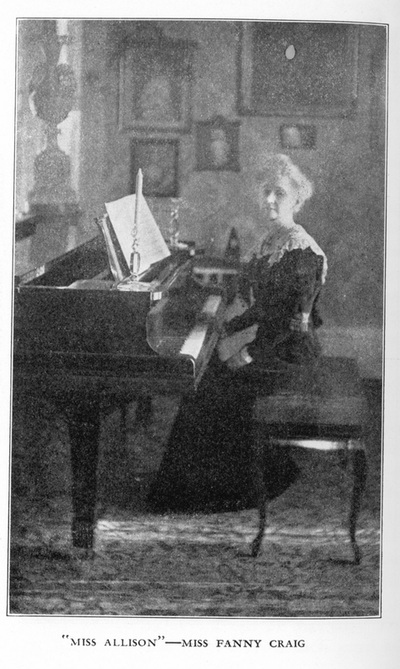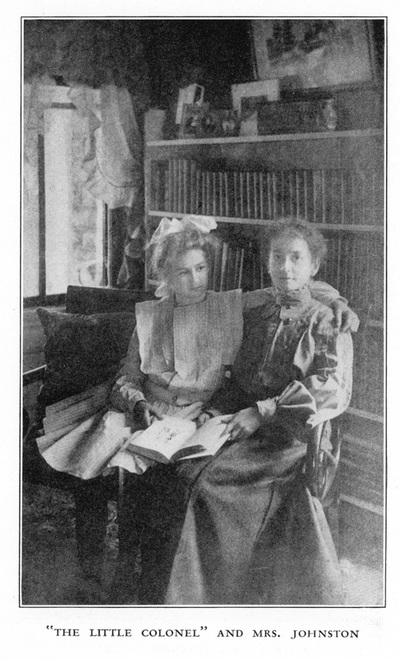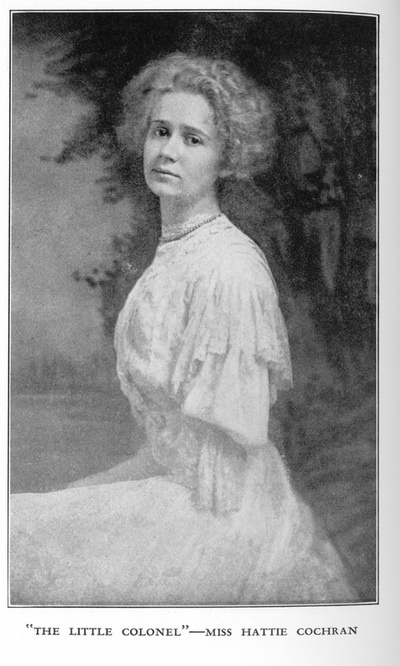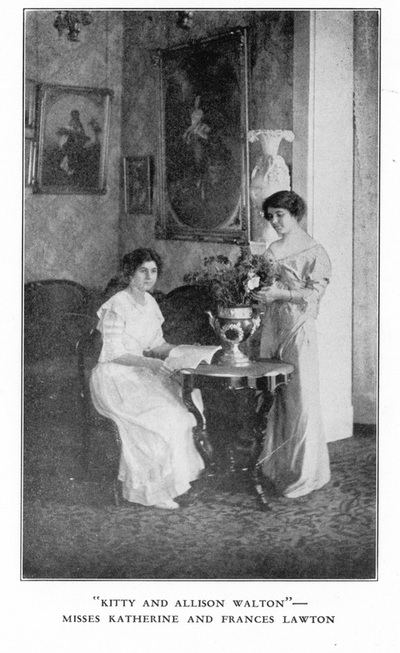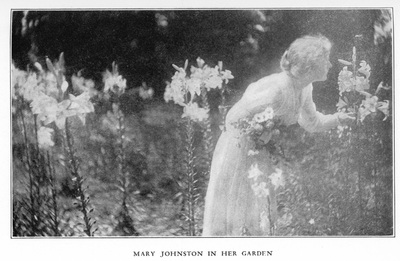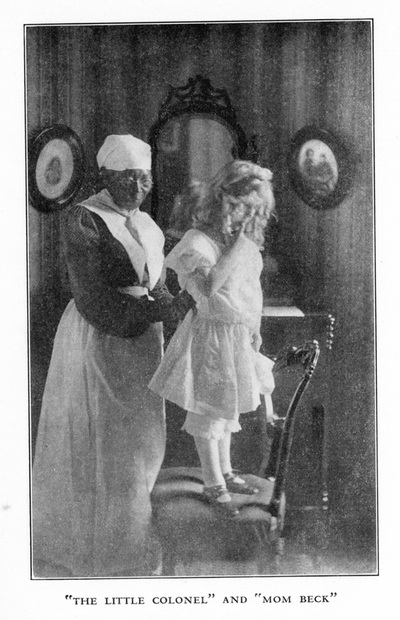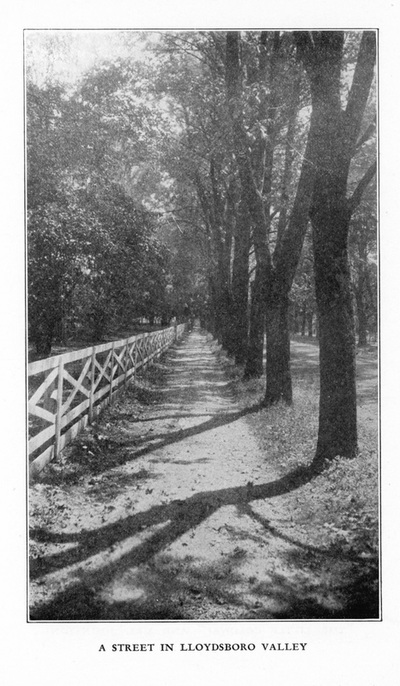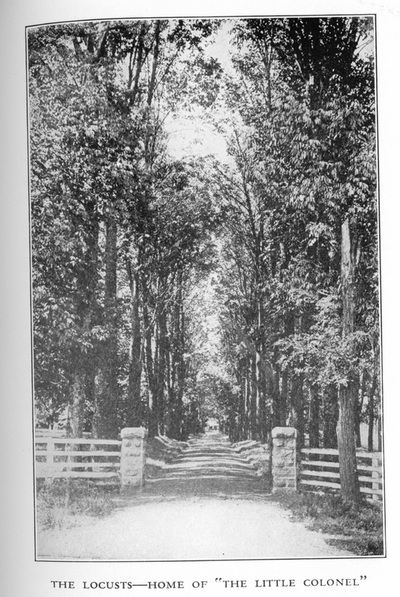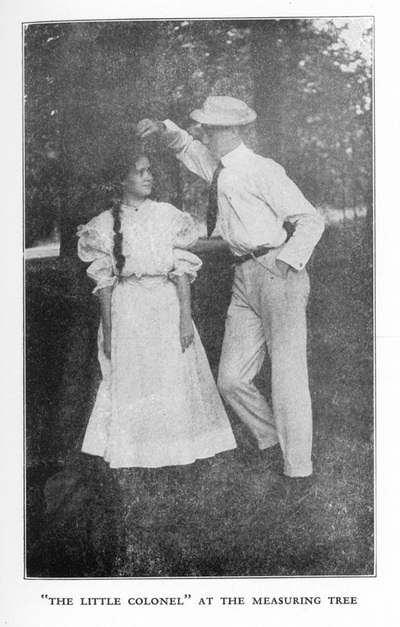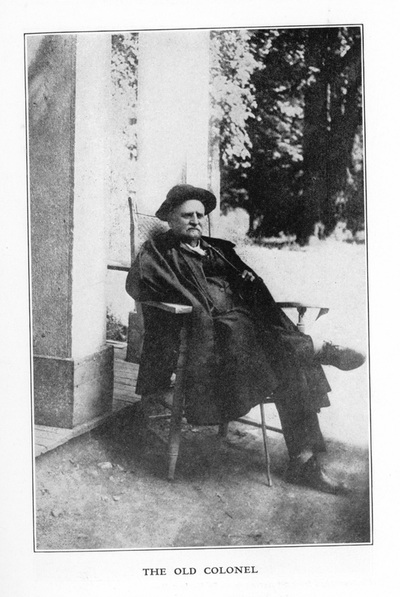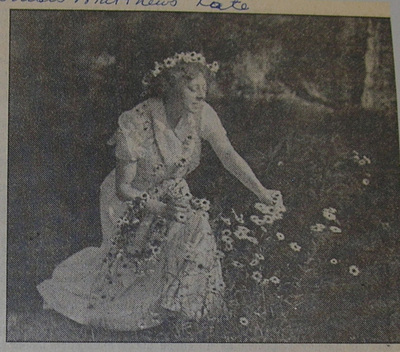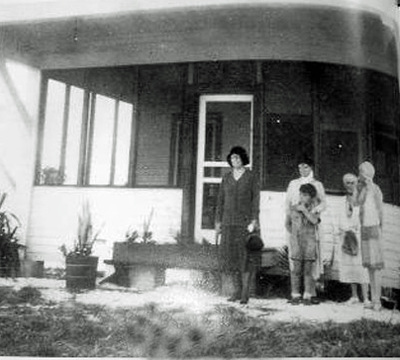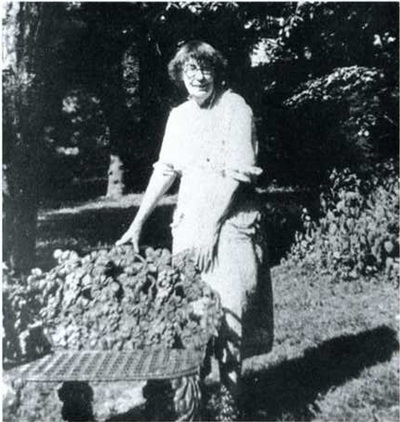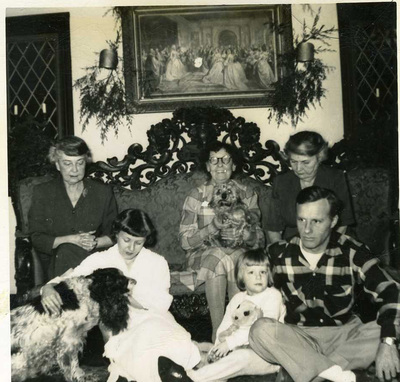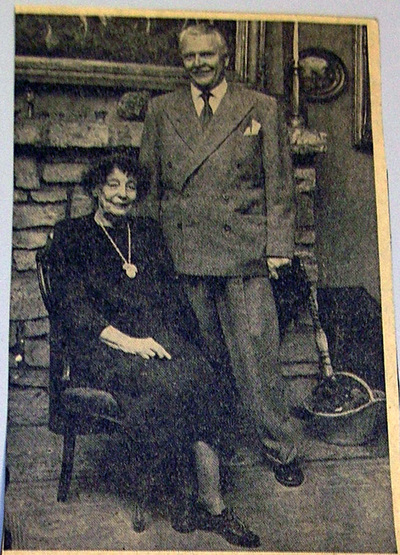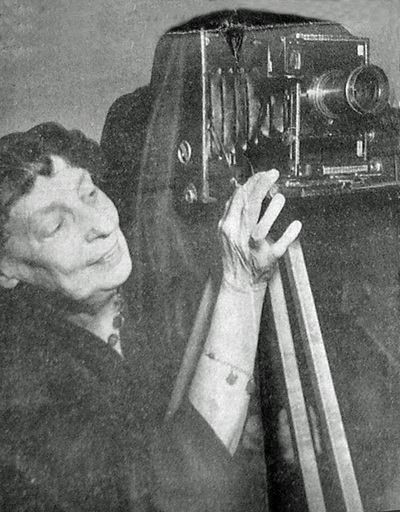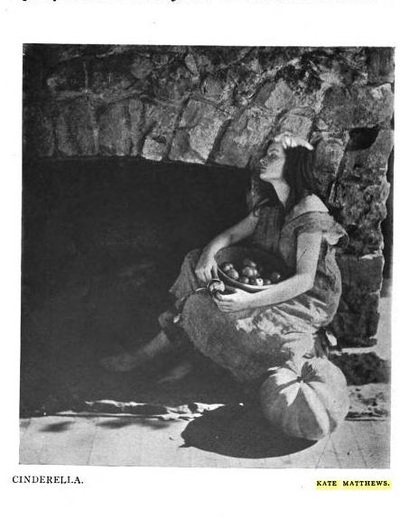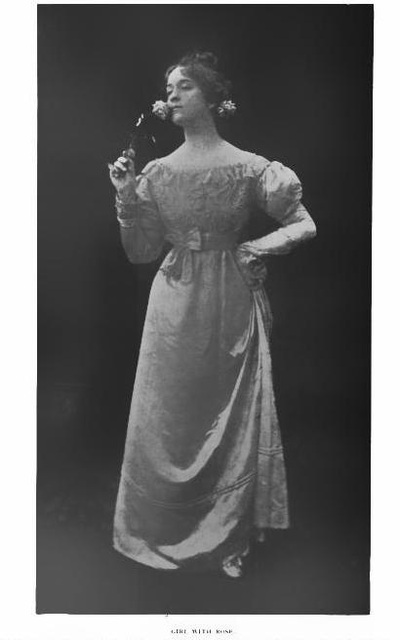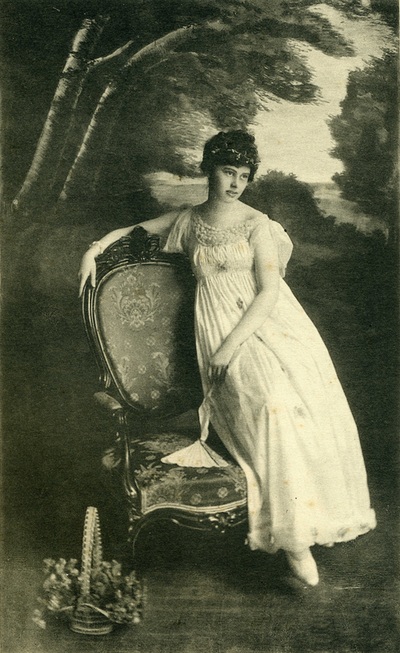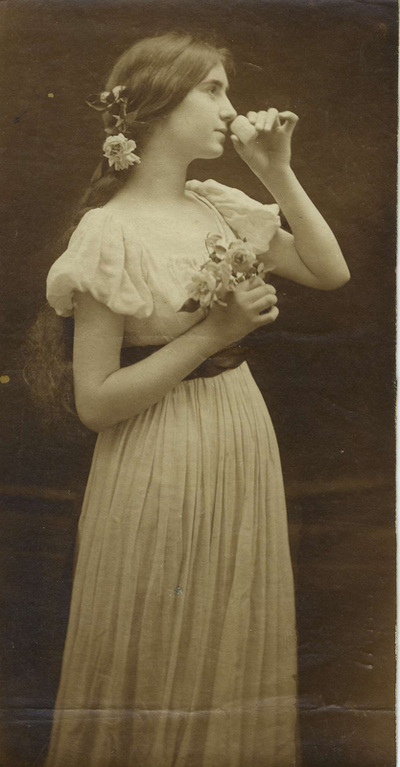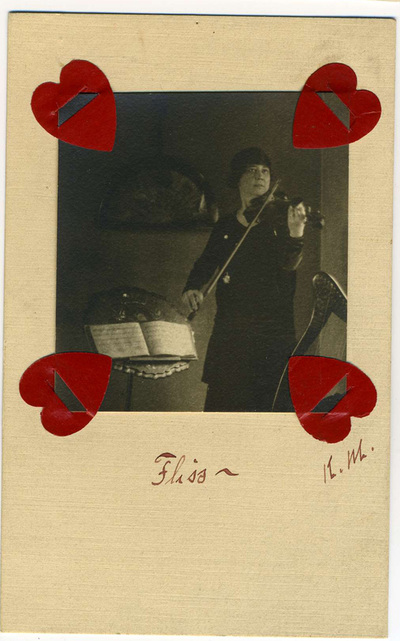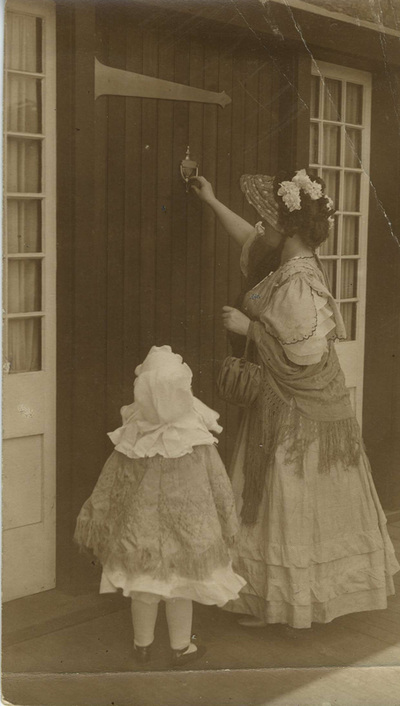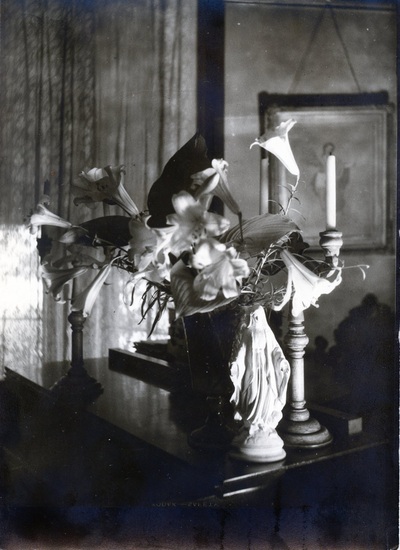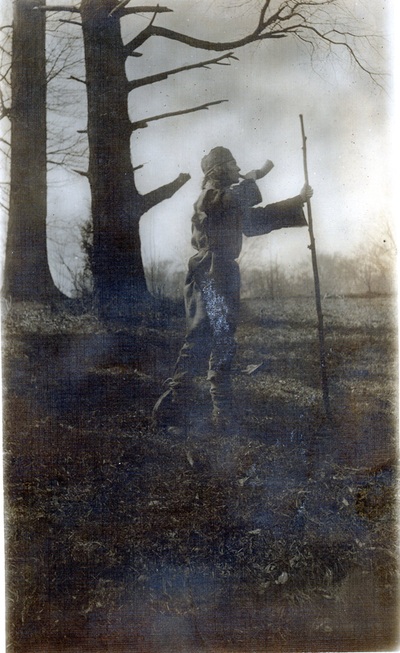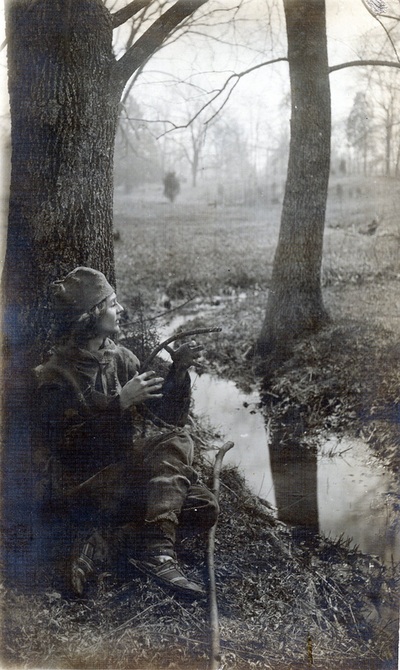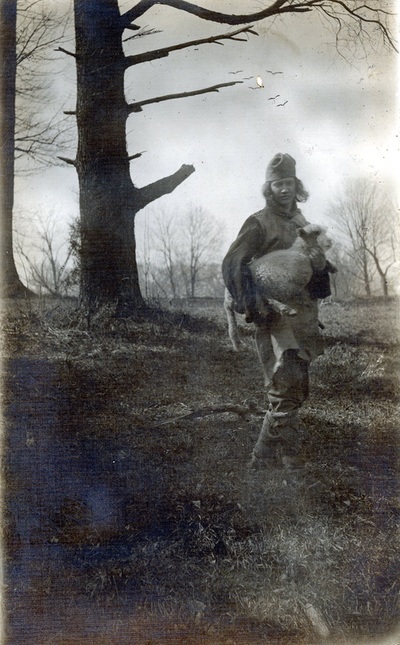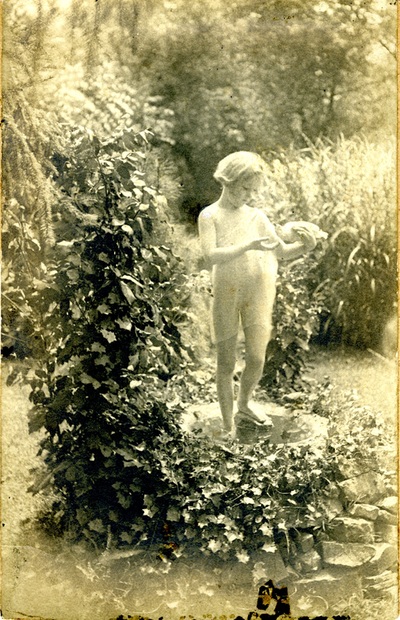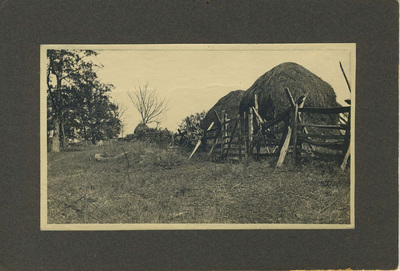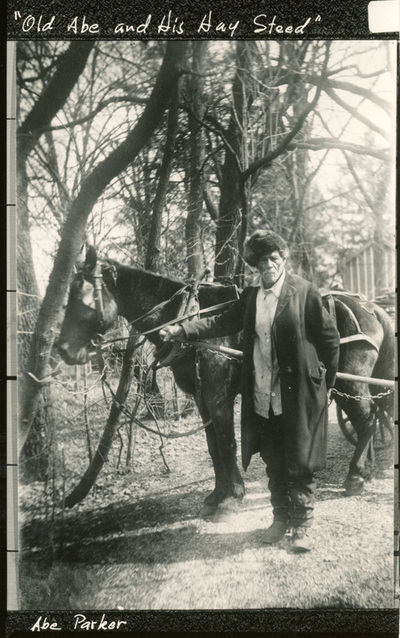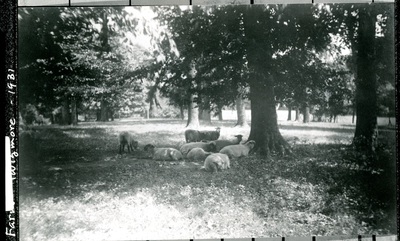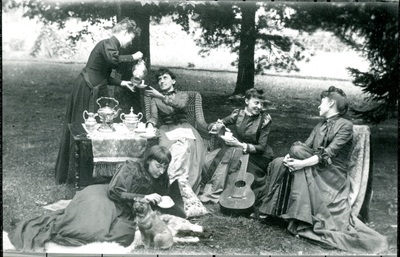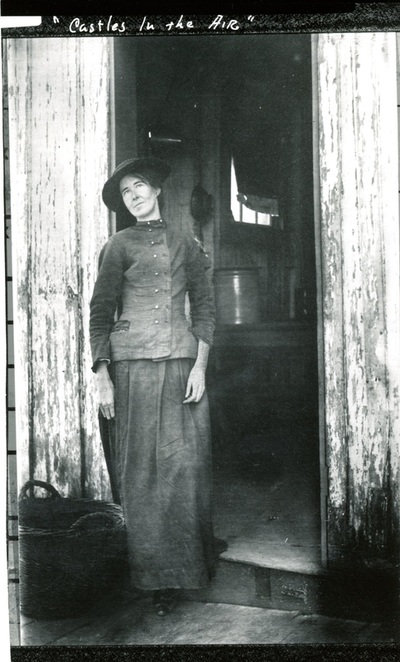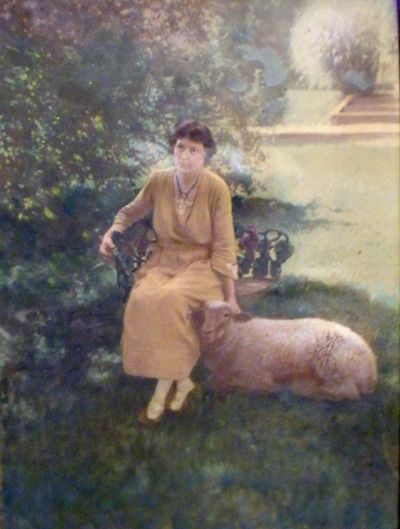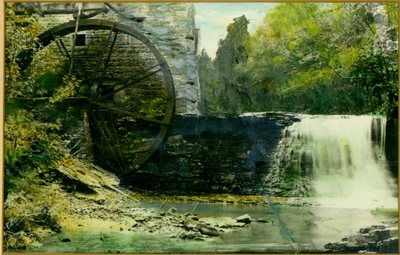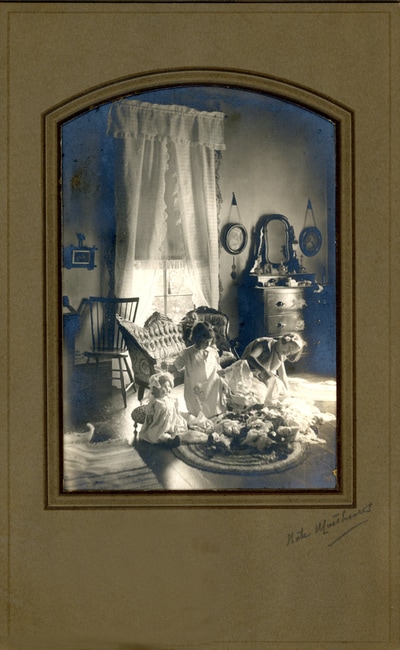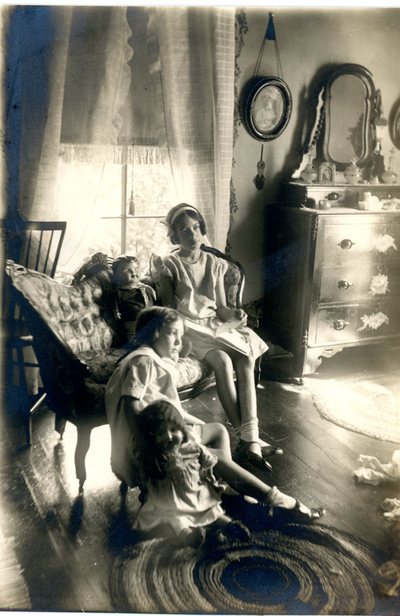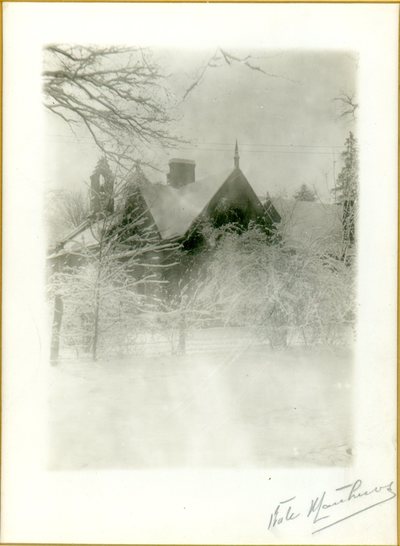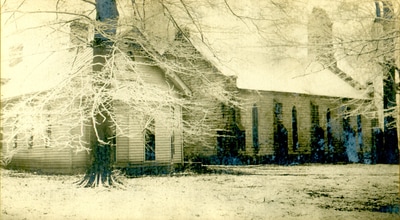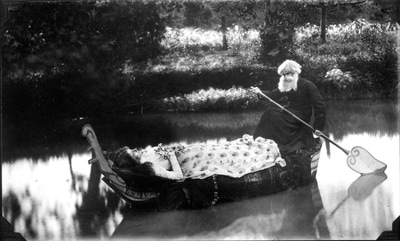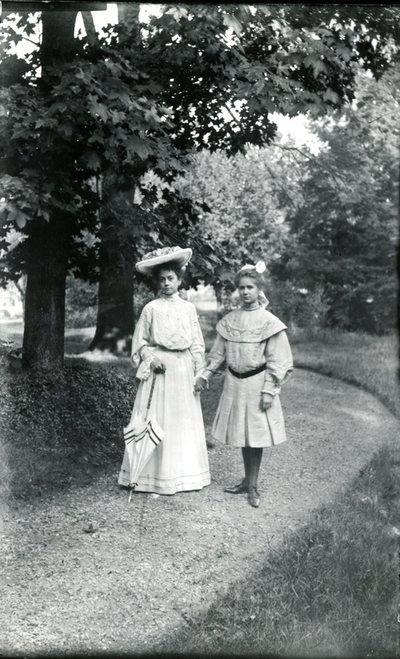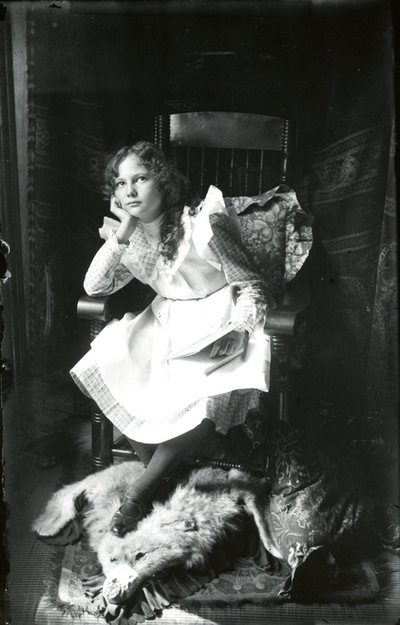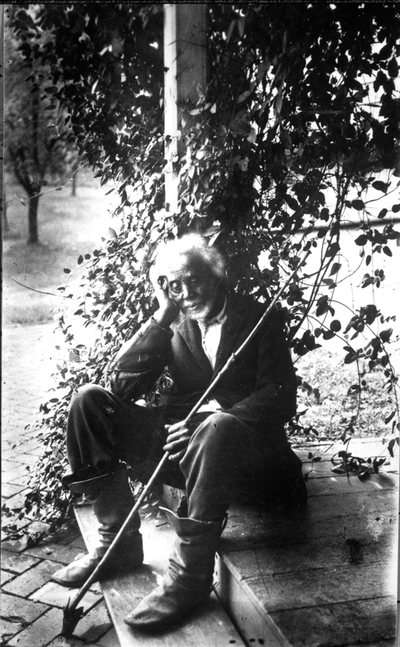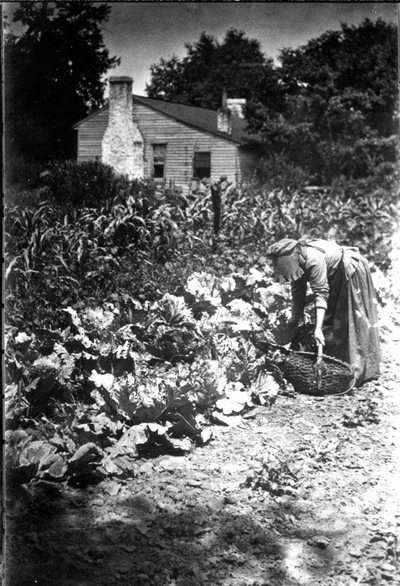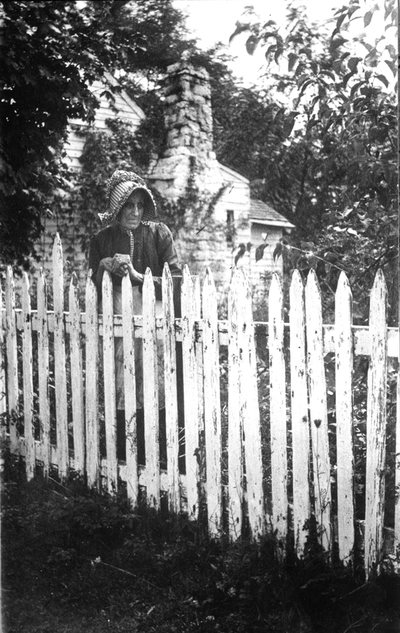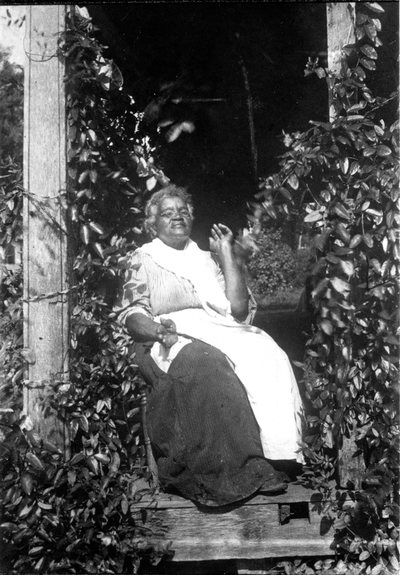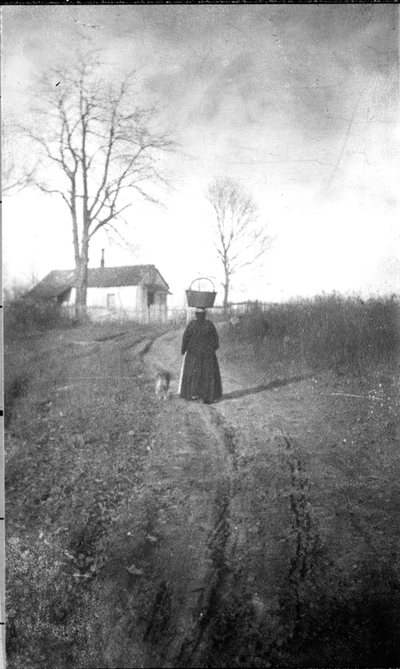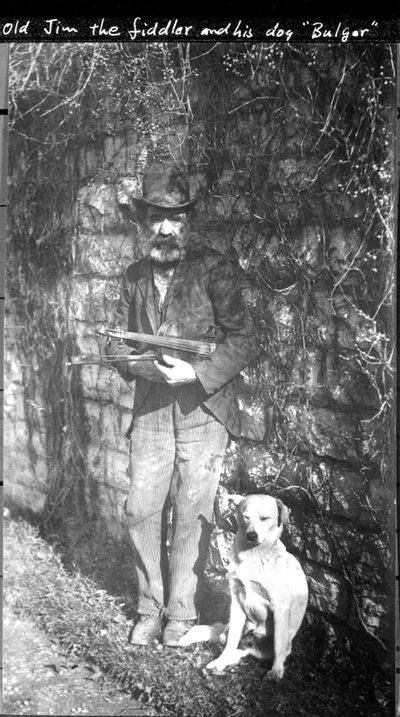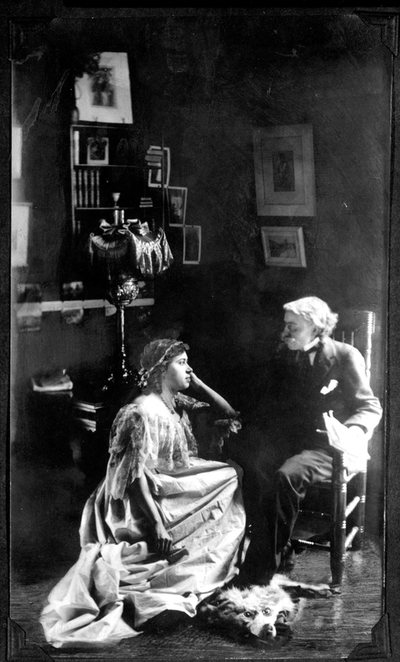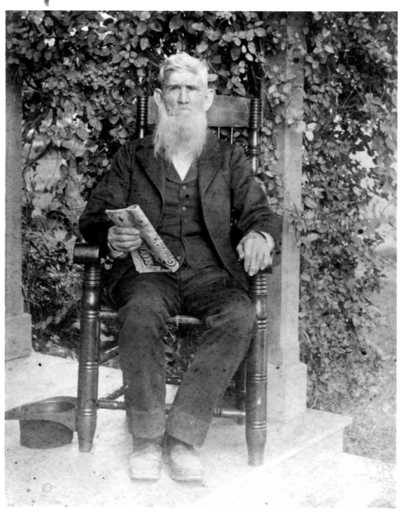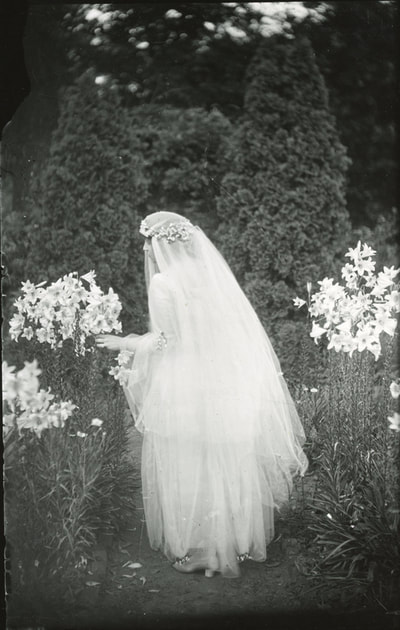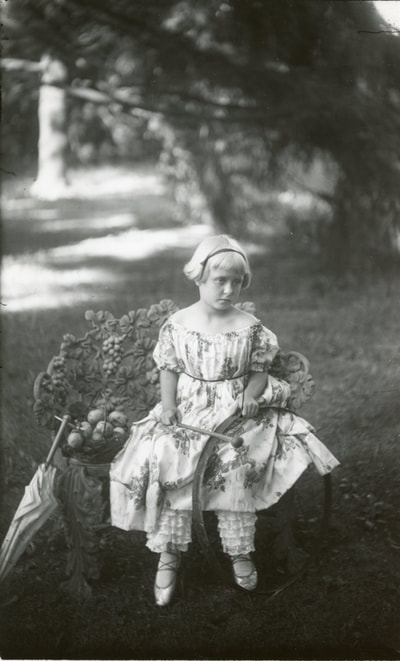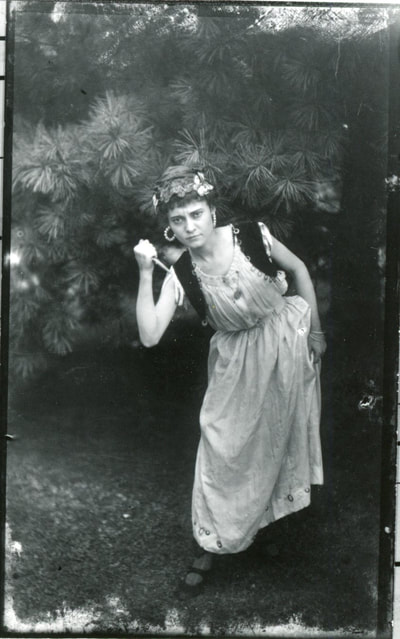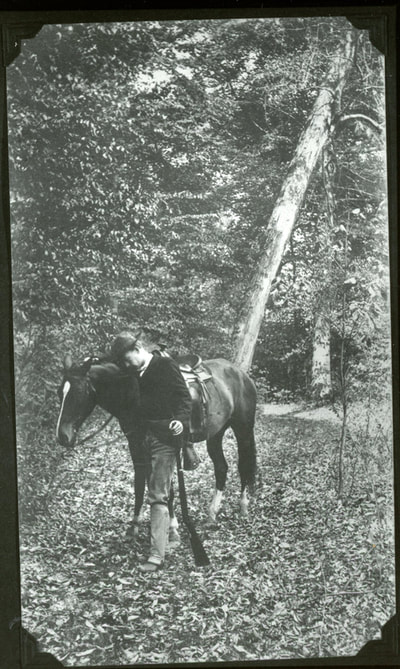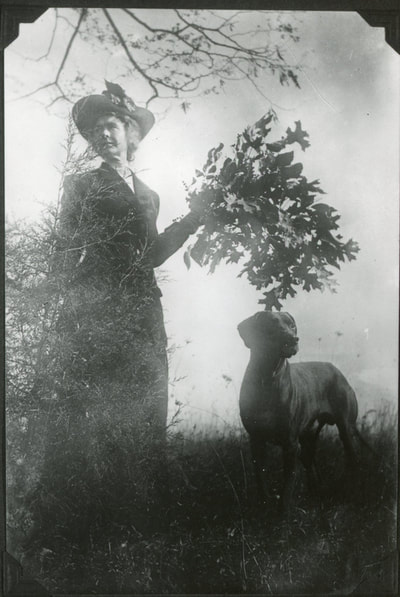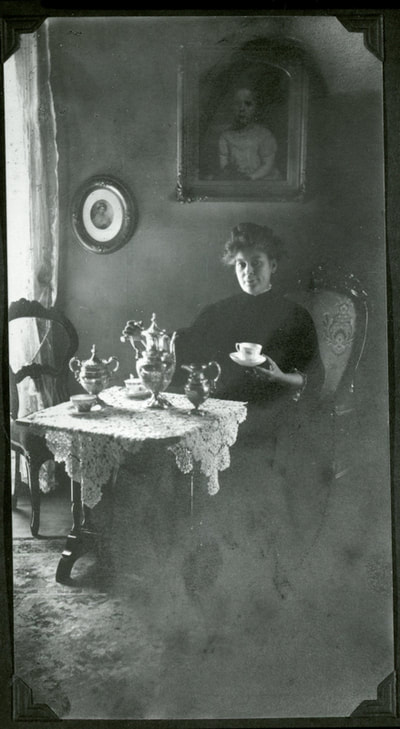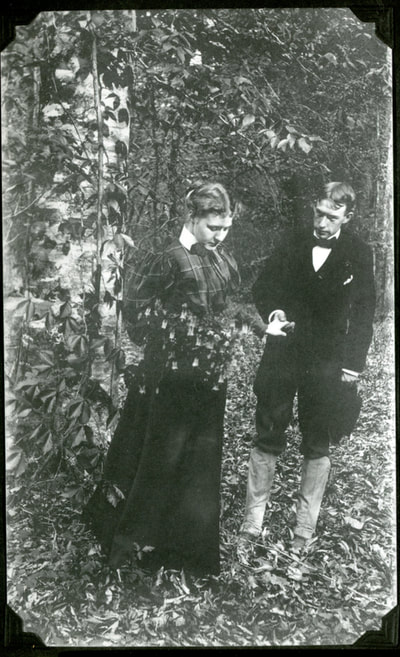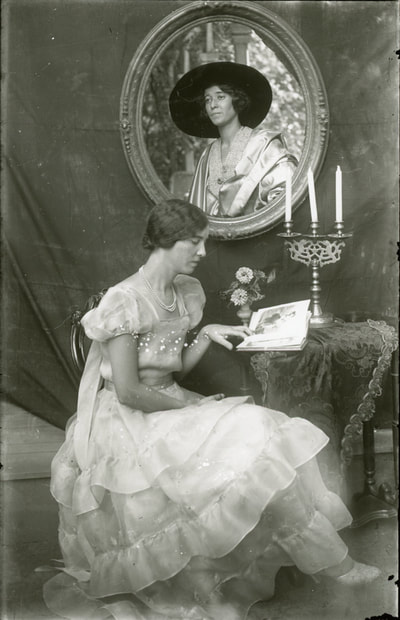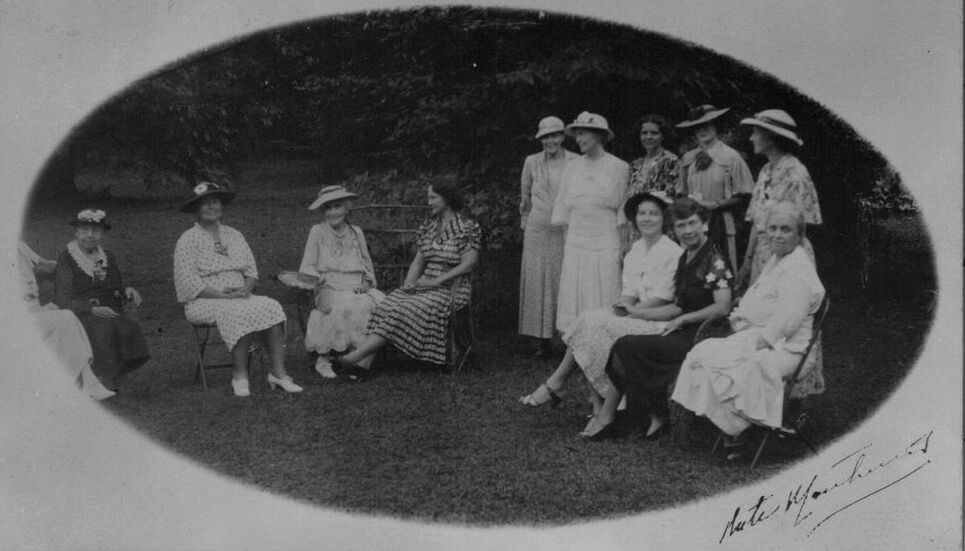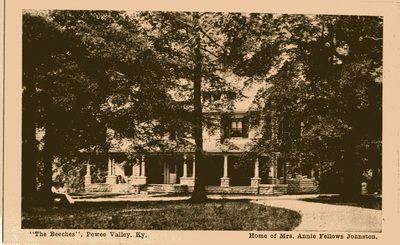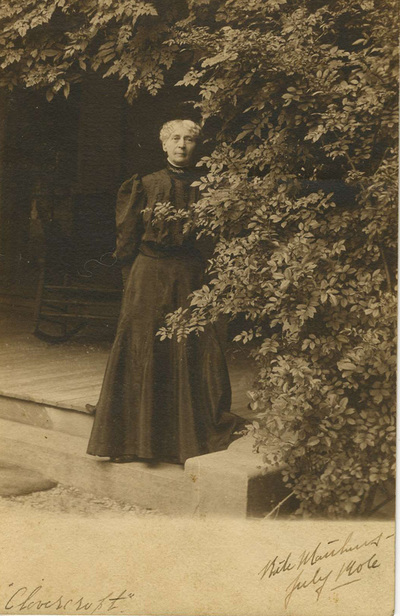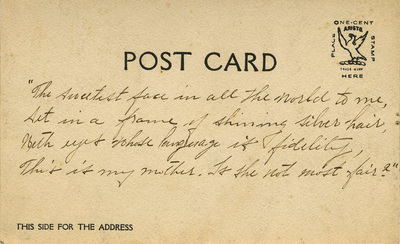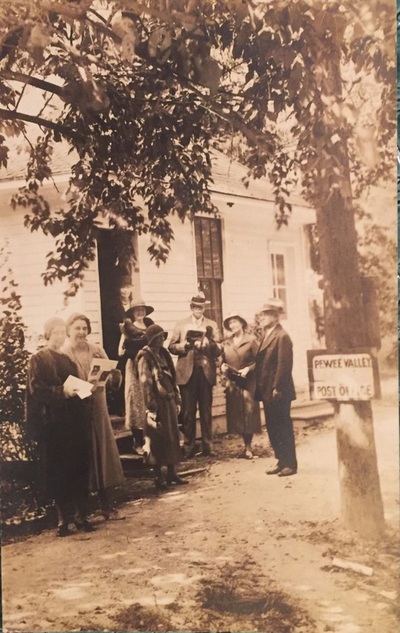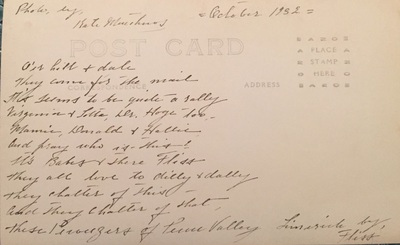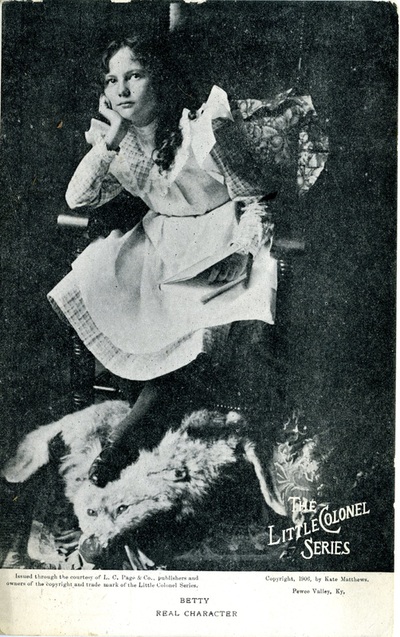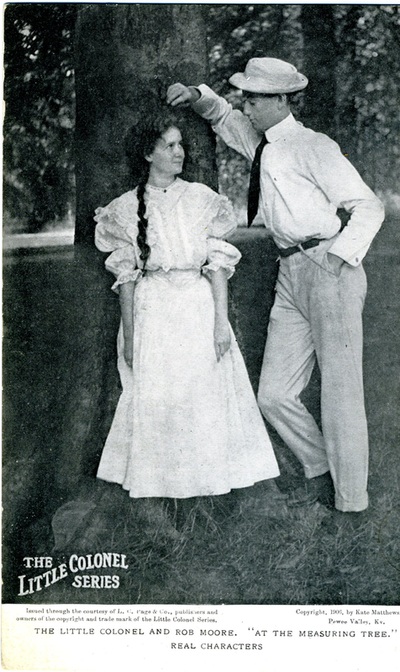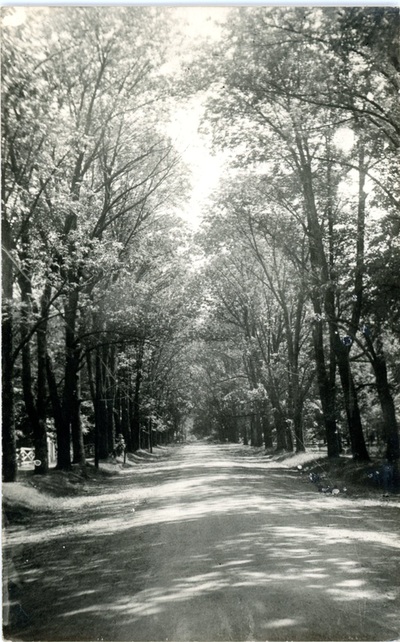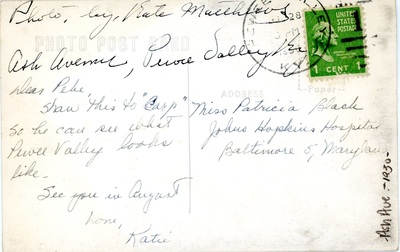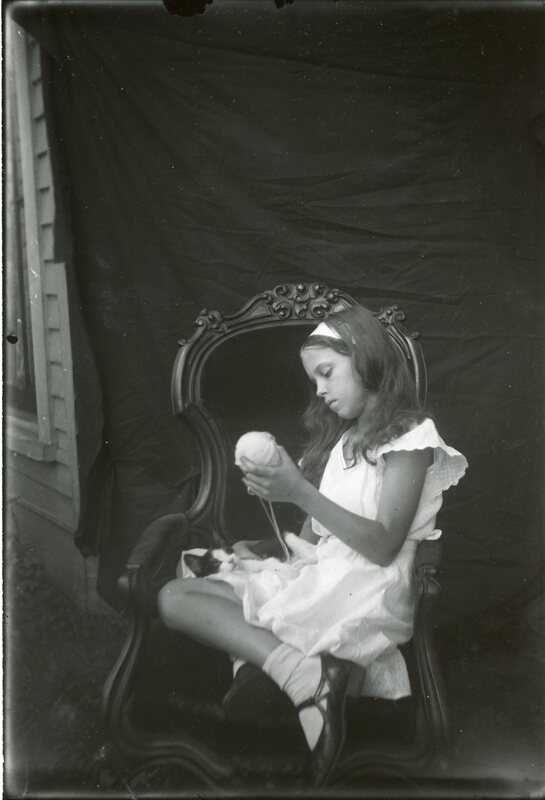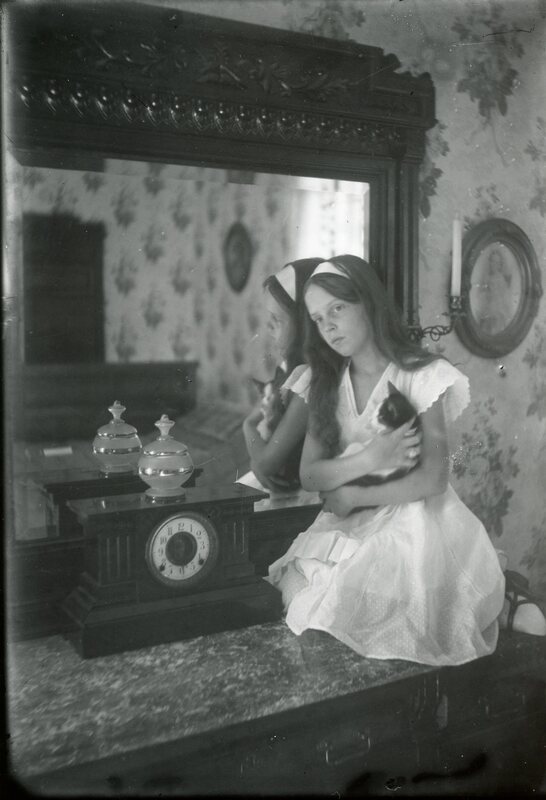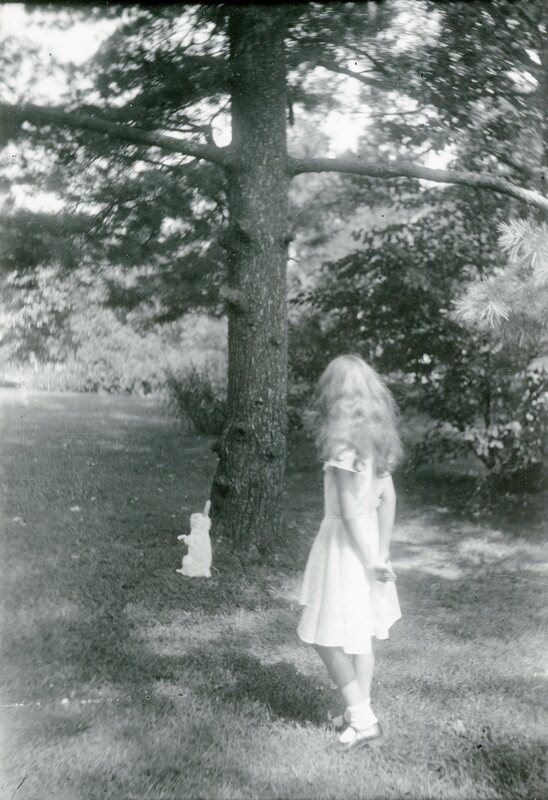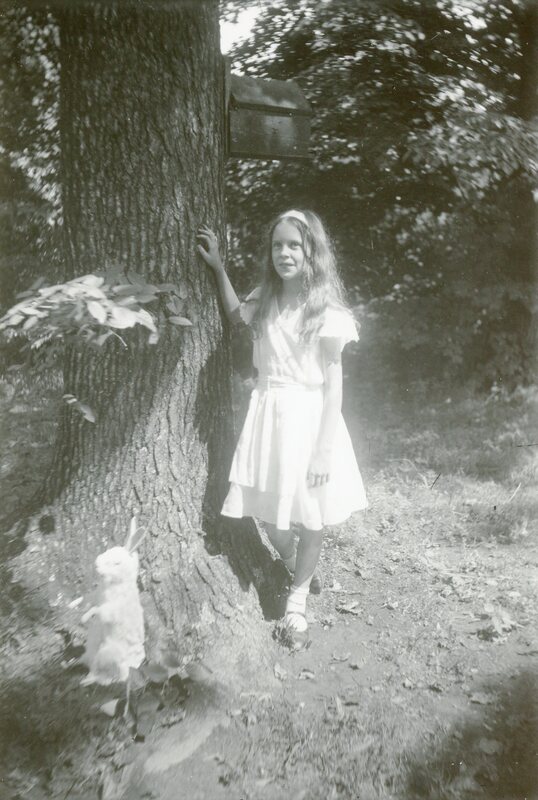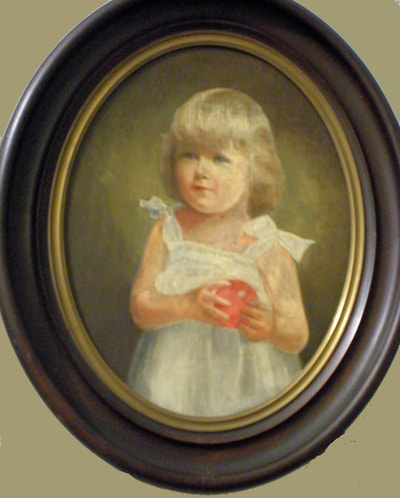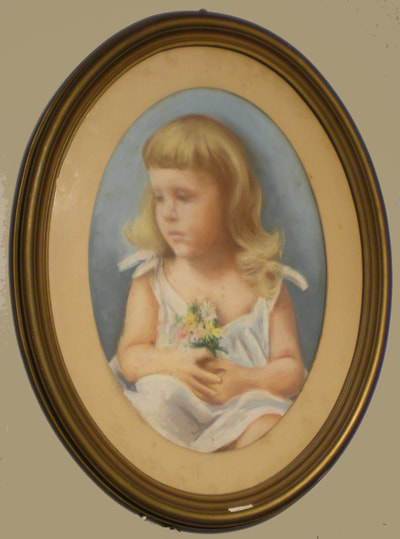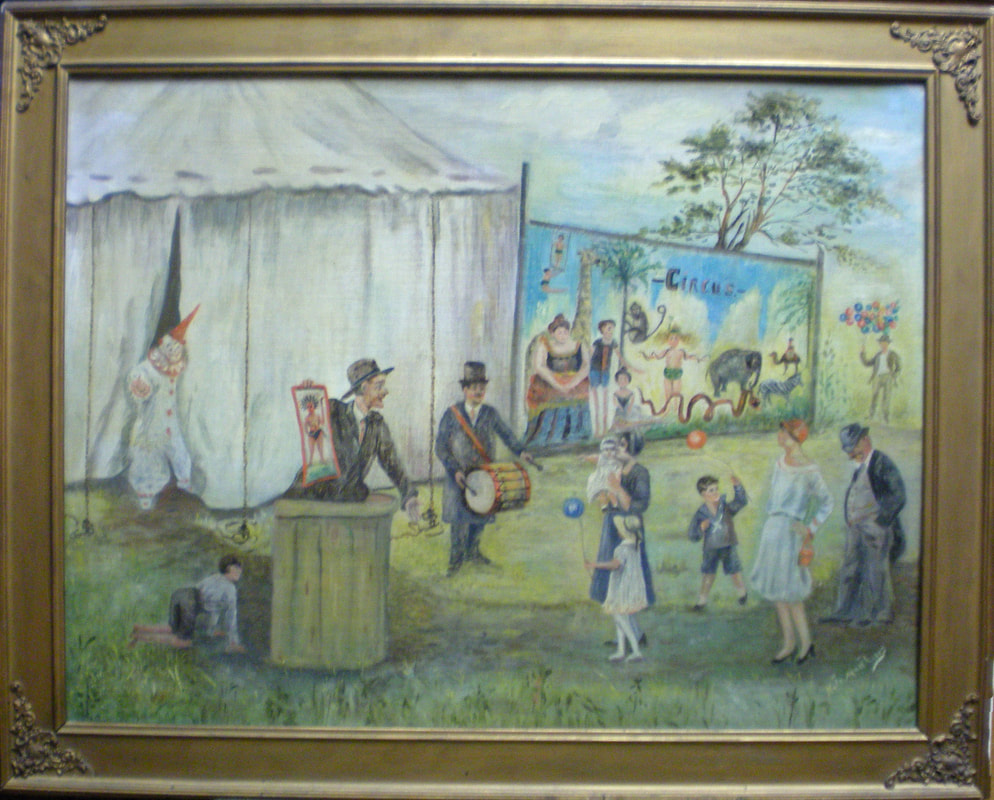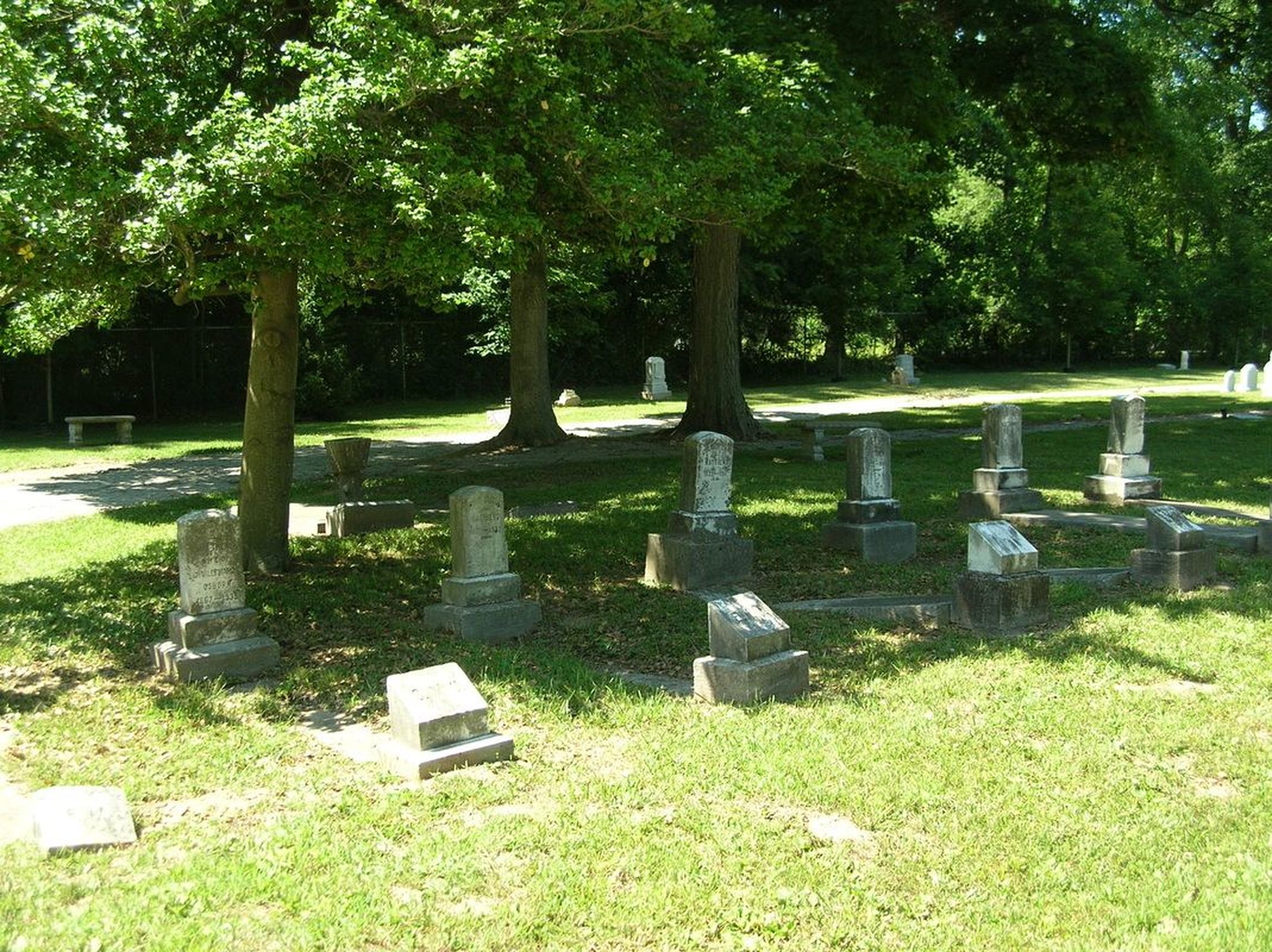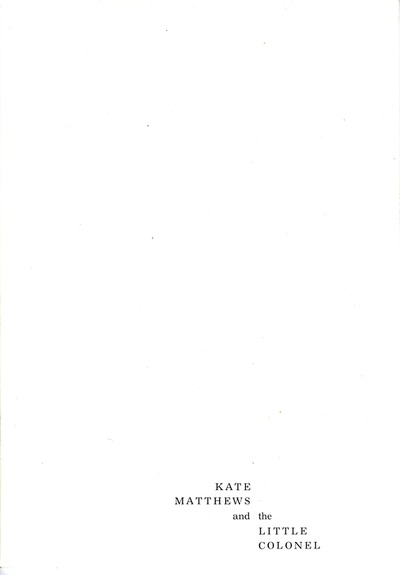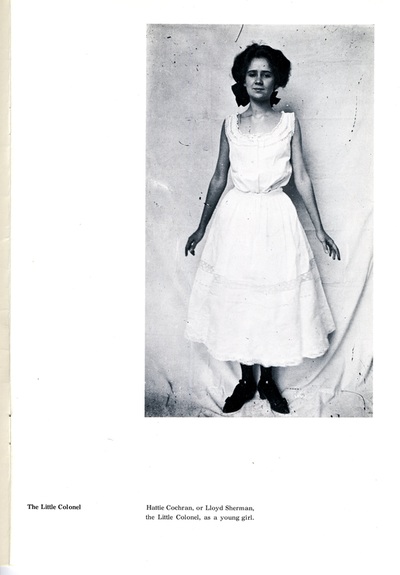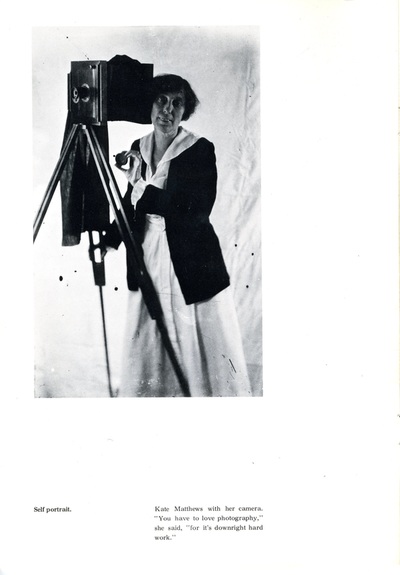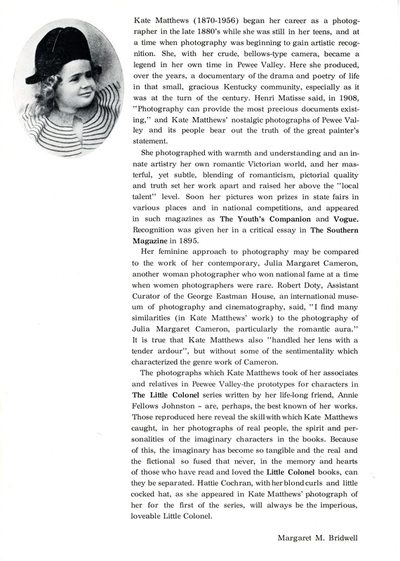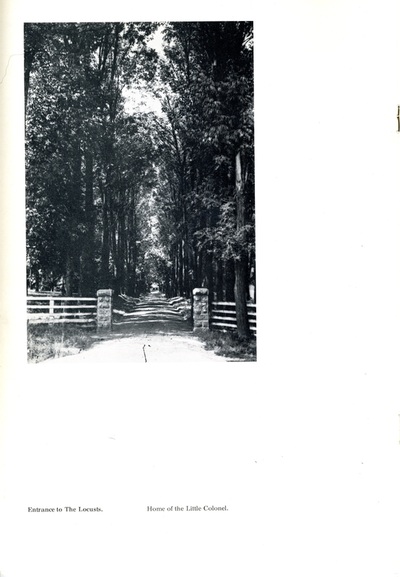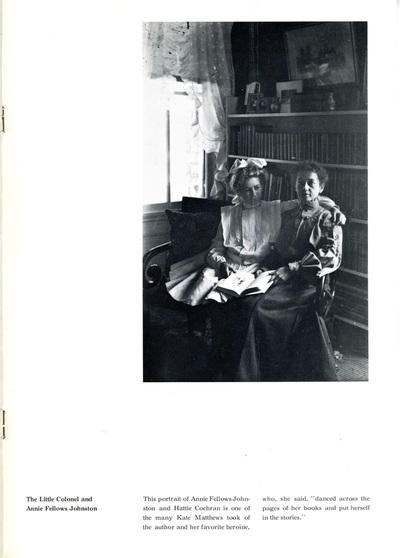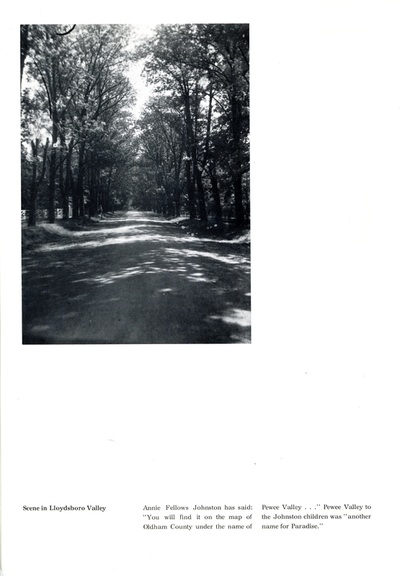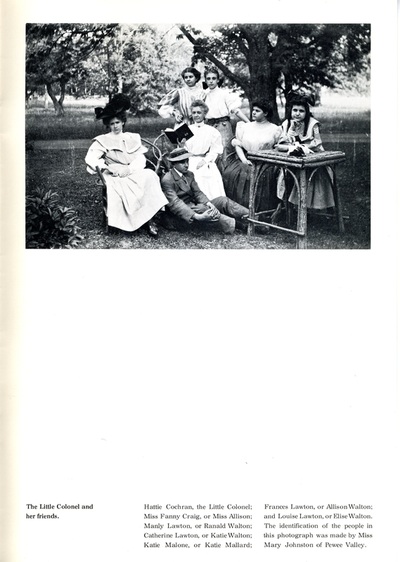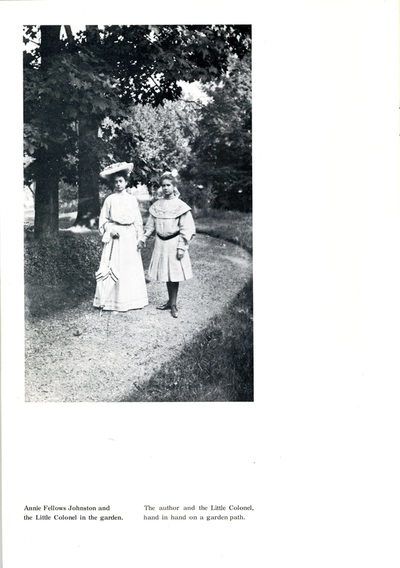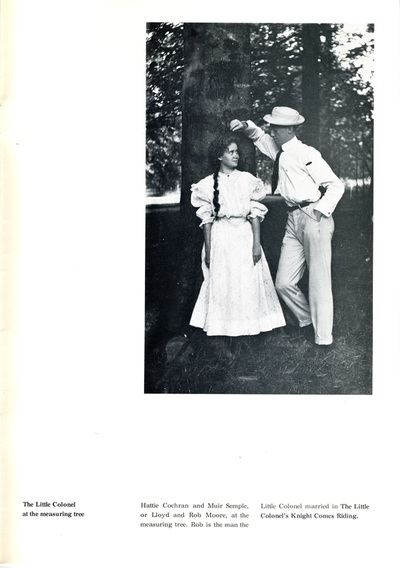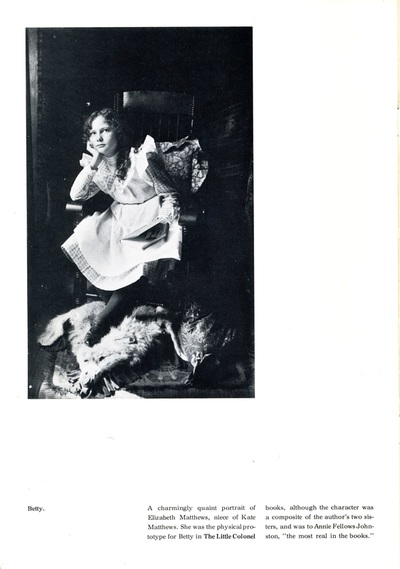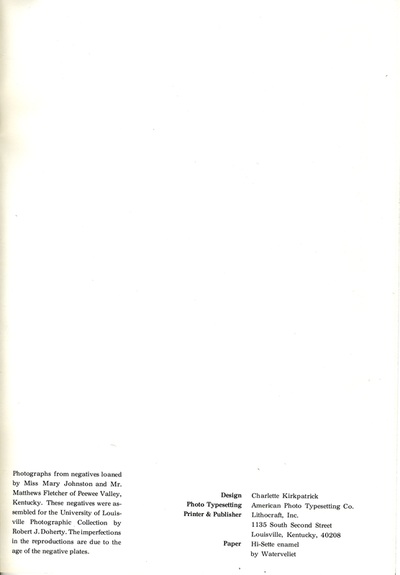Kate Matthews -- Camera Artist (August 13, 1870- July 5, 1956)
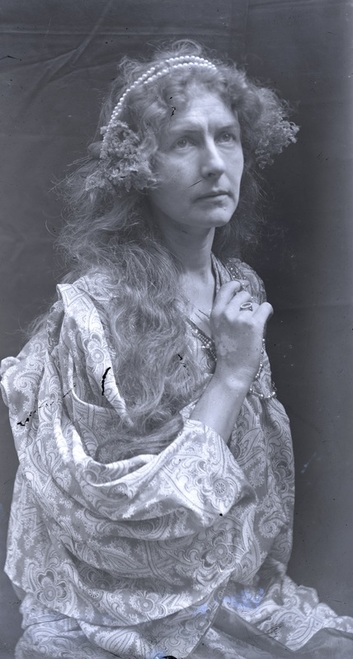 Self-portrait. Klein Koehler Gift to the Oldham County Historical Society.
Self-portrait. Klein Koehler Gift to the Oldham County Historical Society.
Born in New Albany, Indiana, in 1870, pioneer female photographer Kate Matthews spent most of her life in Oldham County. Her parents had purchased a home in Pewee Valley in the 1880s and Kate, who never married, lived at Clovercroft until her death in 1956. The subjects in her photographs ranged from people and places in Pewee Valley and surrounding communities to staged tableaux of Annie Fellows Johnston’s storybook characters. She became the official photographer for the Little Colonel series and provided the photos for Johnston’s autobiography, “The Land of the Little Colonel,” published in 1929.
Annie Fellows Johnston, in fact, turned her into a character in her novels – Katherine Marks, first introduced in “The Little Colonel at Boarding-School” in 1903. Annie Fellows Johnston described her as “an artist” in Chapter VI:
She has a great big camera in her studio, and takes bettah pictuahs than any professional photographah could, because she thinks of all sorts of beautiful things to pose people fo. She gets a medal or a prize every time she places a pictuah on exhibition…
Chapter V of “The Little Colonel’s Knight Comes Riding” noted that Miss Marks only allowed a select few -- those with “artist souls” – admittance to her studio and provided details and secrets about her prize-winning photography:
Miss Marks came out with a large photograph exquisitely tinted. So artistic it was, both in colouring and composition, that Leland's admiration was as great as his surprise. He had expected to see some little snap shots such as he had made himself when he had the kodak fever, the kind that are interesting only to those who take them and those who are taken. This was so beautiful that no sooner was it in his hands than he was fired with a desire to possess it. It was the picture of a rose garden, every bush a glory of bloom, and in the path, her pink dress caught by a clinging brier, was Kitty herself like another rose, looking down over her shoulder at the bramble which held her a prisoner in its thorny clasp.
"It is to illustrate a fairy-tale," explained Miss Marks. "When naughty Esmerelda runs away from the good prince, everything in the garden is in league to help him, and Brier Rose catches at her skirts as she hurries by, and holds her fast."
"Isn't it lovely?" cried Gay, flashing out of the studio with an armful which Miss Marks had given her permission to show. "Here's Betty taken as a nun --- Sister Doloroso --- and Lloyd as an Easter angel. It's perfectly fascinating to hear Miss Marks tell how she got that effect of flying. Arranged the draperies with Lloyd lying on the floor, and photographed her from a trap door above. Tell him how you added the doves' wings please."
Much to her surprise Miss Marks found herself telling things to this young man that she would not have dreamed of telling to another stranger; some of the remarkable makeshifts she had used in costumes and backgrounds...
…The English garden was too far away for them to attempt that morning, but Miss Marks finally agreed that the moonlight scene might be managed. It was just the right time of day to take a moonlight picture, while the sunshine was so direct that it would cast the blackest of shadows. She could retouch the plate to give it the right effect, and paint in a moon.
Annie Fellows Johnston, in fact, turned her into a character in her novels – Katherine Marks, first introduced in “The Little Colonel at Boarding-School” in 1903. Annie Fellows Johnston described her as “an artist” in Chapter VI:
She has a great big camera in her studio, and takes bettah pictuahs than any professional photographah could, because she thinks of all sorts of beautiful things to pose people fo. She gets a medal or a prize every time she places a pictuah on exhibition…
Chapter V of “The Little Colonel’s Knight Comes Riding” noted that Miss Marks only allowed a select few -- those with “artist souls” – admittance to her studio and provided details and secrets about her prize-winning photography:
Miss Marks came out with a large photograph exquisitely tinted. So artistic it was, both in colouring and composition, that Leland's admiration was as great as his surprise. He had expected to see some little snap shots such as he had made himself when he had the kodak fever, the kind that are interesting only to those who take them and those who are taken. This was so beautiful that no sooner was it in his hands than he was fired with a desire to possess it. It was the picture of a rose garden, every bush a glory of bloom, and in the path, her pink dress caught by a clinging brier, was Kitty herself like another rose, looking down over her shoulder at the bramble which held her a prisoner in its thorny clasp.
"It is to illustrate a fairy-tale," explained Miss Marks. "When naughty Esmerelda runs away from the good prince, everything in the garden is in league to help him, and Brier Rose catches at her skirts as she hurries by, and holds her fast."
"Isn't it lovely?" cried Gay, flashing out of the studio with an armful which Miss Marks had given her permission to show. "Here's Betty taken as a nun --- Sister Doloroso --- and Lloyd as an Easter angel. It's perfectly fascinating to hear Miss Marks tell how she got that effect of flying. Arranged the draperies with Lloyd lying on the floor, and photographed her from a trap door above. Tell him how you added the doves' wings please."
Much to her surprise Miss Marks found herself telling things to this young man that she would not have dreamed of telling to another stranger; some of the remarkable makeshifts she had used in costumes and backgrounds...
…The English garden was too far away for them to attempt that morning, but Miss Marks finally agreed that the moonlight scene might be managed. It was just the right time of day to take a moonlight picture, while the sunshine was so direct that it would cast the blackest of shadows. She could retouch the plate to give it the right effect, and paint in a moon.
Photographs Featured in Southern Magazine 1894
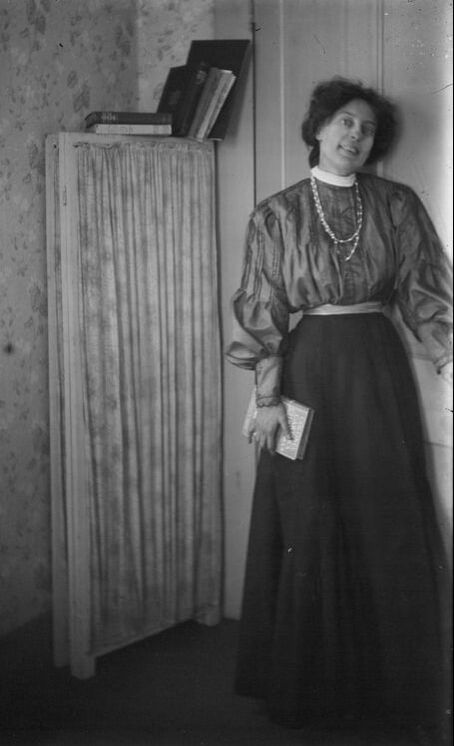 Self-portrait of a young Kate Matthews. From the Richard Duncan Collection.
Self-portrait of a young Kate Matthews. From the Richard Duncan Collection.
Kate was already making a name for herself as an early female photographer when Annie Fellows Johnston first began the "Little Colonel" series. The article below appeared in 1894 in Southern Magazine, Volume 5, a year before the first volume of the "Little Colonel" series was published:
KATE MATTHEWS, CAMERA-ARTIST.
A recent original comment on photography proclaimed it an art resembling law, which, though crowded below stairs, affords plenty of room in the upper story. This charming “ upper story," no doubt, with its airy spaces for aspiration and distinction, is becoming, as time goes on, more and more a popular resort for women. Photography, amateur or professional, offers to woman broad field for entertainment or achievement, and the marvel is that more women have not already made this discovery. It is an art in which the technical points can readily be acquired, and nearly all women possess, far more frequently than men, the requisite discernment of possibilities, the eye for pose and the artistic judgment for detail and execution. In this profession, also, women who have the artist ardor and artistic sense without the creative power of brush, graving-tool or chisel, can satisfy those instincts and enlist themselves among the myriad beauty-makers of the world.
In all large cities are found women whose work has taken rank with the most expert men, notably : Mrs. N. G. Bartlett, of Chicago, who has exhibited at the Vienna Salon, and there won a diploma; Miss C. W. Barnes, of Albany; Mrs. Bullock, of Cincinnati; Miss Clarkson, of New York, and E. S. Needles, of Baltimore. Among women photographers of the South, Miss Kate S. Matthews of Pewee Valley, Ky., has done good and artistic work. She began as an amateur camera-worker five years ago, and has advanced in technical excellence so rapidly that her pictures have been found acceptable by many Eastern publications. In landscape and in portrait-photography alike her work is excellent, albeit in the former specialty her deepest interest is centered.
Pewee Valley, the home of Miss Matthews, lies like an artist's dream of a village, in sylvan surroundings of wondrously beautiful and picturesque quality; and this felicitous collaboration of nature her artist-eye has discerned and used with fine results. As a choice bit of selection from woodland and stream the photographic print, "In Still September" needs no laudation. In the same vicinity of charming natural beauty, is the old home of Kentucky‘s famous painter of beeches, Carl Brenner— the artist who evidently believed with Robert Louis Stevenson that “trees are our most civil society." From the humble dwelling of this celebrated painter stretches away a forest of stately beeches, in whose grand forms and varying moods he found his wealth of inspiration. An idyllic and mossy-banked forestbrook babbles and plashes through this woodland until it passes over the ruins of an old mill-dam, near which stands a dismantled and mouldering mill—a picturesque monument to its own industrious past. Up and down all this classic Carl Brenner land Miss Matthews has tramped with her camera, and has gleaned a rarely fine collection of artistic photographs of the painter’s favorite haunts for the study of nature’s phases. On account of their beauty and historic worth, copies of these valuable Carl Brenner photographs are to be preserved in the archives of the Filson Club of Louisville.
Following a departure in artistic photography made recently by professional camera-workers in New York: namely, portrait-photography, or the reproduction in prose and artistic feeling of celebrated painted portraits of by-gone days, Miss Matthews has evolved a similar original use of her camera – that of character photograph, with illustrative intent, as shown in that mediaeval suggestion, "The Soul's Awakening," and in her typical Southern study, “Lost in Dreams.”
The best work of this young camera artist has so far been done with platinotype paper, with which can be produced effects as soft and artistic as those of a wash-drawing. In broad black and white contrasts-Rembrandt effects-she is also skillful, as evidenced in the misty, dream-like picture, entitled "Moonlight."
Unlike Oscar Wilde and the Whistler school of artists, Miss Matthews believes that nature really has art opinions of her own; that she is sometimes artistic, and frequently idealistic in suggestion, if studied from the proper point of view. Should she successfully demonstrate this fact with her camera, she will, at least, weaken in visible degree a singular theory of the so-called "interpretation" school of art.
KATE MATTHEWS, CAMERA-ARTIST.
A recent original comment on photography proclaimed it an art resembling law, which, though crowded below stairs, affords plenty of room in the upper story. This charming “ upper story," no doubt, with its airy spaces for aspiration and distinction, is becoming, as time goes on, more and more a popular resort for women. Photography, amateur or professional, offers to woman broad field for entertainment or achievement, and the marvel is that more women have not already made this discovery. It is an art in which the technical points can readily be acquired, and nearly all women possess, far more frequently than men, the requisite discernment of possibilities, the eye for pose and the artistic judgment for detail and execution. In this profession, also, women who have the artist ardor and artistic sense without the creative power of brush, graving-tool or chisel, can satisfy those instincts and enlist themselves among the myriad beauty-makers of the world.
In all large cities are found women whose work has taken rank with the most expert men, notably : Mrs. N. G. Bartlett, of Chicago, who has exhibited at the Vienna Salon, and there won a diploma; Miss C. W. Barnes, of Albany; Mrs. Bullock, of Cincinnati; Miss Clarkson, of New York, and E. S. Needles, of Baltimore. Among women photographers of the South, Miss Kate S. Matthews of Pewee Valley, Ky., has done good and artistic work. She began as an amateur camera-worker five years ago, and has advanced in technical excellence so rapidly that her pictures have been found acceptable by many Eastern publications. In landscape and in portrait-photography alike her work is excellent, albeit in the former specialty her deepest interest is centered.
Pewee Valley, the home of Miss Matthews, lies like an artist's dream of a village, in sylvan surroundings of wondrously beautiful and picturesque quality; and this felicitous collaboration of nature her artist-eye has discerned and used with fine results. As a choice bit of selection from woodland and stream the photographic print, "In Still September" needs no laudation. In the same vicinity of charming natural beauty, is the old home of Kentucky‘s famous painter of beeches, Carl Brenner— the artist who evidently believed with Robert Louis Stevenson that “trees are our most civil society." From the humble dwelling of this celebrated painter stretches away a forest of stately beeches, in whose grand forms and varying moods he found his wealth of inspiration. An idyllic and mossy-banked forestbrook babbles and plashes through this woodland until it passes over the ruins of an old mill-dam, near which stands a dismantled and mouldering mill—a picturesque monument to its own industrious past. Up and down all this classic Carl Brenner land Miss Matthews has tramped with her camera, and has gleaned a rarely fine collection of artistic photographs of the painter’s favorite haunts for the study of nature’s phases. On account of their beauty and historic worth, copies of these valuable Carl Brenner photographs are to be preserved in the archives of the Filson Club of Louisville.
Following a departure in artistic photography made recently by professional camera-workers in New York: namely, portrait-photography, or the reproduction in prose and artistic feeling of celebrated painted portraits of by-gone days, Miss Matthews has evolved a similar original use of her camera – that of character photograph, with illustrative intent, as shown in that mediaeval suggestion, "The Soul's Awakening," and in her typical Southern study, “Lost in Dreams.”
The best work of this young camera artist has so far been done with platinotype paper, with which can be produced effects as soft and artistic as those of a wash-drawing. In broad black and white contrasts-Rembrandt effects-she is also skillful, as evidenced in the misty, dream-like picture, entitled "Moonlight."
Unlike Oscar Wilde and the Whistler school of artists, Miss Matthews believes that nature really has art opinions of her own; that she is sometimes artistic, and frequently idealistic in suggestion, if studied from the proper point of view. Should she successfully demonstrate this fact with her camera, she will, at least, weaken in visible degree a singular theory of the so-called "interpretation" school of art.
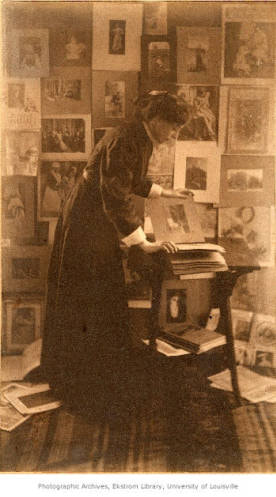 Kate at work in her studio, from the Kate Matthews Collection ULPA 2007.14.086.p University of Louisville Photographic Archives Kate at work in her studio, from the Kate Matthews Collection ULPA 2007.14.086.p University of Louisville Photographic Archives
Kate's dark room was located in Clovercroft's laundry room, according to this story by Florence Dickerson in the May 1974 Call of the Pewee:
... When Kate wanted a dark room so she could develop and print her own pictures, her mother suggested that under the cellar stairs in the laundry room would be suitable. Kate secured a carpenter and explained her need. In order that she could have the necessary running water one of the two laundry tubs had to be removed, and Kate, with her usual independence, directed the carpenter to do this. But forever after, it was always the lament of any one who did the Matthews' laundry that Miss Kate had not had the one laundry tub removed. Her sisters were often exasperated because the bath tub was frequently full of photographic prints which were being washed. This never bothered Kate because she was oblivious to anything mundane when she was involved in photography ... |
Kate Matthews Photographs from "Land of the Little Colonel" by Annie Fellows Johnston
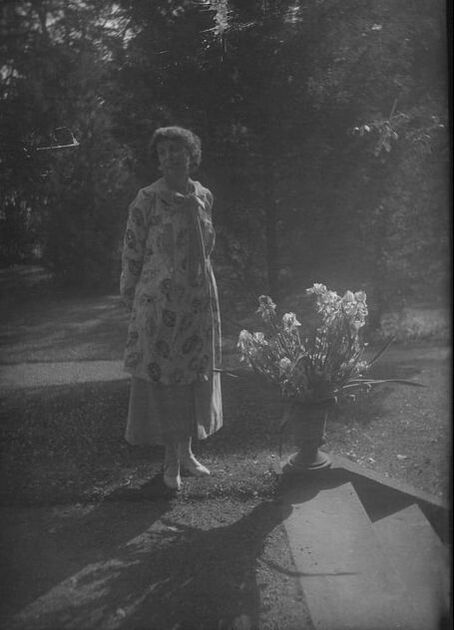
In a November 29, 1942 Courier-Journal story called “These Pictures Will Take You Back” by Bunch Griffin, Kate talked about her 50 years as an amateur photographer:
…Having taught herself everything she knows, which is plenty, Miss Kate has won innumerable trophies, medals and cash prizes for her photographic reproductions of people and scenes around Pewee Valley.
Soon after the late Mr. Matthews sent his 18-year-old daughter Kate a big camera from New York City, the farmers and residents of the southwestern corner of Oldham County became accustomed to seeing Miss Kate with her camera and Miss Mary Johnston with her paints and brushes in a field taking and painting pictures.
One of her favorite subjects being scenes from literature, Miss Kate says she never will forget the farmers, who, while driving a team of horses past a pond saw a woman “lying robed in snowy white” on a barge that was steered by a bearded gentleman, the late Bert Gatchel. Floating down to Camelot was Miss Mary posed as Tennyson’s Elaine. The farmers thought they were crazy.
Preserved in her albums, but seldom shown by their modest owner, are photographs of prominent Louisvillians, many in unusual tableau type pictures, which are specialties of Miss Kate.
“You have to love photography, for it’s downright hard work,” contends Miss Matthews, who has gone to no end of trouble to take some pictures such as the one of Miss Johnston symbolizing Easter. In the attic of Clovercroft, the Matthews home, Miss Kate held her camera in the large trap doorway and took a picture of an angel, Miss Mary, gowned in a white drape and lying on a black shawl. By another process, Miss Kate photographed the wings on the original picture. Many times Kate and Mamie Johnston used to climb through a window in the condemned Episcopal Church building and dress up in the choir’s vestments.
When the photograph of her sister, Mrs. H. M. Joy, was printed in Illustrated American, Miss Kate received a letter from Mr. W. C. Simons of Lawrence, Kan., which said, “Your picture of the young lady with violin struck my fancy and I have worked it up in oil. The painting has been complimented very highly by several newspapermen and it is seldom that I take up my brushes. I am a married man and therefore not looking for flirtation, but out of curiosity, should like to know the name of the original of the photograph.”
One summer afternoon forty years later, Mr. Simons, the publisher and editor of the Lawrence Daily Journal World, called at Clovercroft. Not wanting to disillusion the artist, so she said, Mrs. Joy – the former Jesse Matthews – hid upstairs during his visit.
Miss Florence Matthews says Alexander Woollcott is an ardent admirer of Miss Kate’s work. Not so long ago he came across one of her postcards in Texas and mailed it to his friend, who had introduced him to the charms of Pewee Valley, Mrs. Charles Brackett, the former Elizabeth Fletcher of Pewee, whose husband wrote “The Major and The Minor.” When Mr. Woollcott was last in Louisville, he had lunch with the Matthews sisters in Clovercroft.
…Having taught herself everything she knows, which is plenty, Miss Kate has won innumerable trophies, medals and cash prizes for her photographic reproductions of people and scenes around Pewee Valley.
Soon after the late Mr. Matthews sent his 18-year-old daughter Kate a big camera from New York City, the farmers and residents of the southwestern corner of Oldham County became accustomed to seeing Miss Kate with her camera and Miss Mary Johnston with her paints and brushes in a field taking and painting pictures.
One of her favorite subjects being scenes from literature, Miss Kate says she never will forget the farmers, who, while driving a team of horses past a pond saw a woman “lying robed in snowy white” on a barge that was steered by a bearded gentleman, the late Bert Gatchel. Floating down to Camelot was Miss Mary posed as Tennyson’s Elaine. The farmers thought they were crazy.
Preserved in her albums, but seldom shown by their modest owner, are photographs of prominent Louisvillians, many in unusual tableau type pictures, which are specialties of Miss Kate.
“You have to love photography, for it’s downright hard work,” contends Miss Matthews, who has gone to no end of trouble to take some pictures such as the one of Miss Johnston symbolizing Easter. In the attic of Clovercroft, the Matthews home, Miss Kate held her camera in the large trap doorway and took a picture of an angel, Miss Mary, gowned in a white drape and lying on a black shawl. By another process, Miss Kate photographed the wings on the original picture. Many times Kate and Mamie Johnston used to climb through a window in the condemned Episcopal Church building and dress up in the choir’s vestments.
When the photograph of her sister, Mrs. H. M. Joy, was printed in Illustrated American, Miss Kate received a letter from Mr. W. C. Simons of Lawrence, Kan., which said, “Your picture of the young lady with violin struck my fancy and I have worked it up in oil. The painting has been complimented very highly by several newspapermen and it is seldom that I take up my brushes. I am a married man and therefore not looking for flirtation, but out of curiosity, should like to know the name of the original of the photograph.”
One summer afternoon forty years later, Mr. Simons, the publisher and editor of the Lawrence Daily Journal World, called at Clovercroft. Not wanting to disillusion the artist, so she said, Mrs. Joy – the former Jesse Matthews – hid upstairs during his visit.
Miss Florence Matthews says Alexander Woollcott is an ardent admirer of Miss Kate’s work. Not so long ago he came across one of her postcards in Texas and mailed it to his friend, who had introduced him to the charms of Pewee Valley, Mrs. Charles Brackett, the former Elizabeth Fletcher of Pewee, whose husband wrote “The Major and The Minor.” When Mr. Woollcott was last in Louisville, he had lunch with the Matthews sisters in Clovercroft.
A Collection of Photos of and by Kate Matthews
Address by Lillian Fletcher Brackett
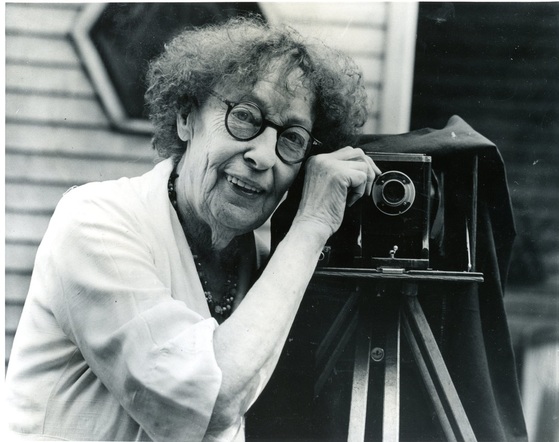 Kate Matthews poses with her box camera. From "Pewee Valley: Land of the Little Colonel" published in 1974 by Katie S. Smith.
Kate Matthews poses with her box camera. From "Pewee Valley: Land of the Little Colonel" published in 1974 by Katie S. Smith.
Kate’s niece, Lillian Fletcher Brackett of Twigmore, gave an eloquent address about her late aunt called “Recollections of Kate Matthews,” on May 31, 1974 to the Oldham County Historical Society. It provided many details about Kate’s career:
One hundred and four years ago on the 13th of August, Kate Matthews was born in New Albany, Indiana. That ‘13’ may have seemed an unlucky number, when, while she was still a baby she caught whooping cough, probably from one of her seven brothers and sisters which left her very delicate and weakened one eye so badly that their doctor advised her parents not to send her to school, but have her privately taught at home. Her education therefore was unique and a perfect backdrop for her creative imagination’s development.
Her older brother, Gustavus, was a writer, later editor of the “Courier-Journal.” He read to her constantly while he was at home, and taught her to love poetry and learn it by heart.
Her sisters were musical. Florence played by ear everything she heard. Jessie was so talented she became a pupil of Leschetizky in Berlin. Lillian, the eldest, painted well and taught little Katie. Her mother and father collected Italian paintings and her sister, Charlotta Osborn, lived in Chicago after her marriage and took Katie on rounds of its museums and galleries. Besides this family devotion, Kate had the best tutors to keep her up with girls her age.
This was all very sufficient when she was little, but as she grew into her teens, her oldest sister Lillian and her husband, Charles Barrow Fletcher, my father and mother, feared that she was lonely. She was shy and very quiet and had no interests outside her home. They asked her to spend the summer with them in Vermont to get her away.
My father was a camera enthusiast and found that Katie was interested in all phases of his photography. He wrote her father, Lucien Matthews, that Kate might have found the very thing she would like to do if she had a camera of her very own.
Soon after, her father went on a trip to New York and bought the finest professional camera he could find – a great big heavy box with a tripod and an extra fine lens and a case of glass plates ‘as big as a bread box.’ And a yard square of black cloth to to on her head and the camera to shut out the light and make it dark inside like a black tent while she focused on what she was taking by pulling a sort of accordion bellows in and out until she got the image clear on the ground glass – and to make it more difficult, the image was upside down.
We have the first pictures she may every have taken. One is of four children pulling sleds through the snow in Vermont – the other the same four children – my brothers and sisters – I was not yet born – off on a hunting trip, for bunnies perhaps, armed with guns held very correctly with a beagle hound scenting game going before. The children’s ages probably three to five, seven and eight. It is a charming amusing picture with criticisms on the back of each as to timing and focusing in my father’s handwriting. I presume that Kate was fifteen or sixteen.
In those days and indeed throughout her life she developed and printed her own pictures. They are so especially hers that one can tell at a glance a Kate Matthews photograph.
To go back to the workings of her camera which she used for many years or others quite like it – after her upside down view of her subject was to her liking she put a leather cap over the lense, inserted a wooden frame into the top of the camera underneath the black cloth, took off the cap, counted one, two, three or the time she felt was needed for the prevailing light, put the cap on again, pushed a black shield down into the plate frame, took the frame out of the camera, folded it in another cloth and tenderly put it in another box for safe keeping. Quite different from the click of a camera today – an awkward operation to describe but done with such method and precision by her.
In the early Pewee Valley days she had a cart and pony to take her about and carry the load and we visiting children loved to go along to an old mill or to take Story Book pictures in a Fairytale glade. Sometimes even acting as characters and always there was a picnic basket tucked in somewhere. When we walked we had to help lug plates and tripod and once even a boat. It was hard work, but – such honored work. Then home again and rest for us but for her all sorts of mysteries in Kate’s dark room behind its red glass window pane – and often horrid odors escaped. The only chemical we knew by name was hypo, which was Aunt Kate’s pug dog’s name. I believe that we thought he too had some part to do in the developing. After a long while she would emerge from this witches den with the developed plates and later with sensitive paper in frames and it is my impression that this too was shrounded in black and clasped to her heart as she ran to a window uncovered the frame whispered a few magic words and clasping it again against her chest raced for the dark room. Sometimes we found pictures floating in the bath tub, why we never knew but often when we wanted a bath Aunt Kate’s pictures had gotten there first.
When Kodaks became popular friends and family sent her the latest models. She tried them, was interested in them but she went right back to her dear old camera which was part of her…
…The “Courier-Journal” has often featured Kate Matthews pictures and sent feature writers to interview her. Once they sent a couple of photographers out to take her picture for a special article on her life. They brought with them a whole battery of lights which they focused on her as she sat on a sofa in her library. Afterward she showed them her albums of pictures. One was of her sister Jay Joy seated on the same sofa. “This is beautifully lighted, Miss Matthews. How did you get this effect without spot lights?” “I am very conscious of light,” she said. “I watch it from day to day and when it is where I need it, I use it.” “As simple as that,” they said laughingly.
As simple as that were all her masterpieces, as simple as light itself. She saw beauty and captured it even in the white wash of a cottage door she used to frame a weather beaten old face leaning against it. She seemed never to lack for inspiration. As children we were suddenly called upon to wade in a creek or swing high in a swing. Iva Barbee was an instant goose girl driving a flock of geese down a creek bed. Mary Johnston became a nun with the Matthews icehouse as a lovely chapel in the backbround. The wash woman carrying a huge bundle of clothes on her head as she walks down a path to her cabin at sunset, where even the smoke from the chimney sets the mood for the picture hard work behind her, a big washing before her, but this evening ‘The Lord Be Praised’ a fire and food and laughter. Then there is her fine picture of ‘Miss Sara” leaning over the gate to chat with a passerby completely unconscious of her own beauty but proud of her neat garden and cozy home. It is more than a picture, it is a poem, a true moment of life fixed forever by an artist in time.
How often we have all said “We woke up this morning to find everything covered with a soft blanket of snow it made the trees look as if they had been etched black on white but it melted away when the sun came out.” Kate caught it before it got away with the first beam of light. It is perfect.
I used to think that the soft clearness of her pictures was a mystery known only to herself and that indeed is partly true. Perhaps without her kind of camera, her mechanics of developing and printing, her pictures would be less exquisite. Of course, it must be a great advantage to see what you are taking, full picture size, on the ground glass and perhaps that is part of her amazing composition, but where did she get that lovely soft light?
…I remember when she took “The Windy Line.” We were at breakfast in the dining room probably ten of us at least. It was a hot summer morning with the door to the long side porch open toward the orchard and the sound of the Old Confederate Soldier pumping water from the cistern up into the big lead tank in the attic and the rub-a-dub-dub and splash of wash day could be plainly heard. Suddenly, Aunt Kate left her breakfast half eaten and disappeared in a quiet trance. She was often dreamy and nothing every interfered with her genius when it was burning. After breakfast we scattered to pick flowers, feed the chickens or eat cherries, sickle pears or perhaps grapes in the shadowy tunnel of the grape arbor and there in the meadow was Aunt Kate covered by the black cloth, taking a picture of the wind blown sheets on the clothes line that looked like a ship in full sail billowing with the wind, and that is why their sheets were so fragrant when I visited them as a child and went to sleep upstairs in the big breezy old house racked by the music of piano and violin from the music room downstairs.
And to go back to the Old Confederate Soldier of whom there is somewhere a picture. Every house had its old Confederate soldier, or so it seemed to us. He pumped water, did small gardening jobs and raking for tobacco money. They lived at the Confederate Home on the hill where the Villa Ridge Hotel had been in earlier days. I am sure I have seen half a dozen photographs of Kate’s Soldiers. They were handsome, young and brave or very old. They were romantic and photographic. She took her younger brother Edward in his K.M.I. uniform when he was a lad. Later she turned him into a wounded Confederate, with a sword and crutch and a blanket over his missing leg, and later she took a Soldier’s Farewell (a real tear jerker) with Mary Johnston as the lovely golden haired girl leaning from her horse to say “Goodbye.” She took my brother in his New World War I Cavalry uniform walking off to war…
Tramps and orphans and old people touched her gentle sense of pity. Tramps came off the railroad and got regular handouts at the kitchen door spring and fall. I suppose on their way north or south when the freight trains side-tracked here long enough for them to catch a bit and a cup of coffee. “Don’t give me any of that bread and jelly stuff. I want meat in my sandwich and milk in my can.” He came for several years, would never sit on the step and eat or use a cup, just an old rusty can. We were all so curious about him until Aunt Kate saw him stop at the gate where his hound dog was waiting to snatch the meat and eagerly lap milk from the can. All those years he had been begging for his dog, so next time he came she would give them both their dinners with meat and milk and coffee and take their pictures but he never came again.
Jim Felton used to come by with his dog and his fiddle and play for us. I don’t remember who he was, except his name and I used to even know the name of his doge, but he and his dog are immortalized by Kate’s camera…
There was no aspect of the Valley that she did not wish to press between the covers of an album and cherish always. She was proud of its beautiful houses, their shaded lanes and lacy fences. Its gracious ladies in high ceilinged houses. Miss Fanny Craig beside her Powers statue of the Greek Slave. Annie Fellows Johnston writing busily upstairs in her study, May Dulaney in her round garden of roses and lilies and her Valentine of a house, Mary Johnston’s lilies and even a bride in her wedding grown picking lilies. She looks like a lily herself but you wonder if this was before or after the ceremony. Her Alice through the looking glass is of her niece Elizabeth Brackett Moore and is adorable and of course her Little Colonel characters made famous by the books especially Betty in the big arm chair reading.
She often hired Abe Parker and his horse to go with her while she picked up bottles, cans and papers trying to keep The Valley unspotted from the careless, and there was real understanding and affection between Old Abe and Kate…Abe had a very old mare and an even older carriage that had seen elegant days. I like to think that I remember that it had a bud base in it for a ladies single rose. Abe sat of course in the coachman’s seat in a coonskin cap and drove his ancient mare with a thin little wisp of a colt running by its mother’s side and when he stopped to pick up trash it nursed its mother.
The story I remember was that Abe had worked for Mr. Wooldridge long ago. One day Mr. Wooldridge joked with Abe about his old mare lasting so long, and Abe offended said she wasn’t old, just tired and thin. “Well,” said Mr. Wooldridge, “If she is so young, Abe, why don’t you bring her over here and have her bred to my fine stallion and then you’ll have yourself a race horse.” And much to Mr. Wooldridge’s surprise and Abe’s delight that is how Abe got his colt…
Kate photographed our blacksmith, Mr. Jacob Herdt, tall, strong, handsome in his leather apron looking out of the door of his smithy with a Ringling Brothers poser slapped onto the wall beside him of a bare back rider on her galloping horse.
…Whenever Kate was pressed for funds she entered a contest and often she won top prize and sometimes that meant $100.00 but she never really enjoyed photography for money. She was very modest about her prizes and only when they were published did we know about them. She had letters from well known, quite great photographers congratulating her and asking about her methods and she corresponded with some, now famous, when they were starting like Edward Steichen and Stiglitz, who gave praise and criticism and advice….
Jim Felton used to come by with his dog and his fiddle and play for us. I don’t remember who he was, except his name and I used to even know the name of his doge, but he and his dog are immortalized by Kate’s camera…
There was no aspect of the Valley that she did not wish to press between the covers of an album and cherish always. She was proud of its beautiful houses, their shaded lanes and lacy fences. Its gracious ladies in high ceilinged houses. Miss Fanny Craig beside her Powers statue of the Greek Slave. Annie Fellows Johnston writing busily upstairs in her study, May Dulaney in her round garden of roses and lilies and her Valentine of a house, Mary Johnston’s lilies and even a bride in her wedding grown picking lilies. She looks like a lily herself but you wonder if this was before or after the ceremony. Her Alice through the looking glass is of her niece Elizabeth Brackett Moore and is adorable and of course her Little Colonel characters made famous by the books especially Betty in the big arm chair reading.
She often hired Abe Parker and his horse to go with her while she picked up bottles, cans and papers trying to keep The Valley unspotted from the careless, and there was real understanding and affection between Old Abe and Kate…Abe had a very old mare and an even older carriage that had seen elegant days. I like to think that I remember that it had a bud base in it for a ladies single rose. Abe sat of course in the coachman’s seat in a coonskin cap and drove his ancient mare with a thin little wisp of a colt running by its mother’s side and when he stopped to pick up trash it nursed its mother.
The story I remember was that Abe had worked for Mr. Wooldridge long ago. One day Mr. Wooldridge joked with Abe about his old mare lasting so long, and Abe offended said she wasn’t old, just tired and thin. “Well,” said Mr. Wooldridge, “If she is so young, Abe, why don’t you bring her over here and have her bred to my fine stallion and then you’ll have yourself a race horse.” And much to Mr. Wooldridge’s surprise and Abe’s delight that is how Abe got his colt…
Kate photographed our blacksmith, Mr. Jacob Herdt, tall, strong, handsome in his leather apron looking out of the door of his smithy with a Ringling Brothers poser slapped onto the wall beside him of a bare back rider on her galloping horse.
…Whenever Kate was pressed for funds she entered a contest and often she won top prize and sometimes that meant $100.00 but she never really enjoyed photography for money. She was very modest about her prizes and only when they were published did we know about them. She had letters from well known, quite great photographers congratulating her and asking about her methods and she corresponded with some, now famous, when they were starting like Edward Steichen and Stiglitz, who gave praise and criticism and advice….
Membership in Pewee Valley Presbyterian Church
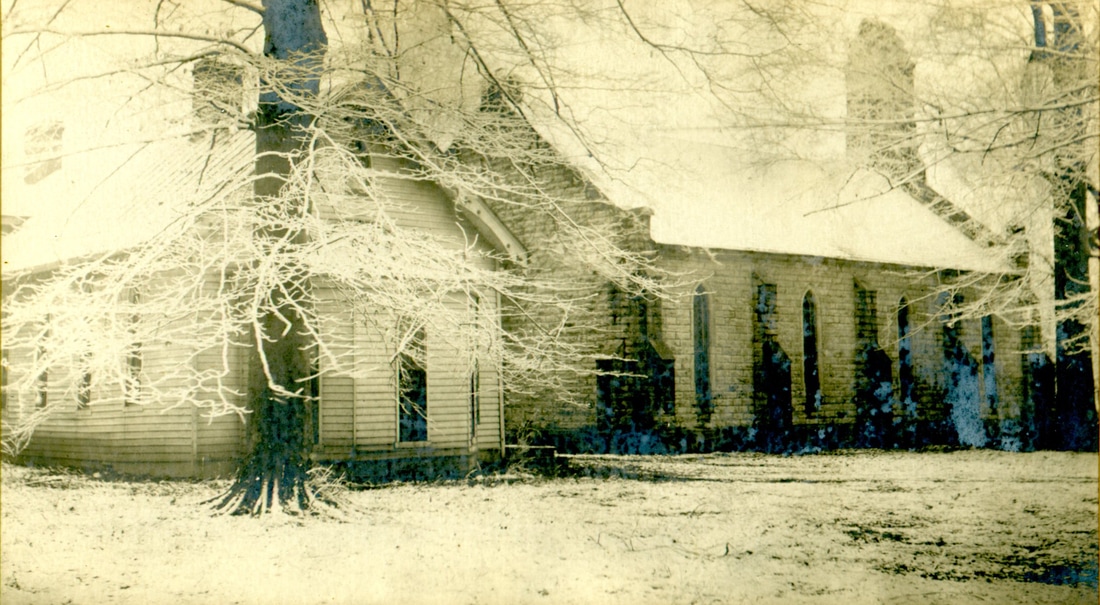 Kate Matthews photo of the Pewee Valley Presbyterian Church and manse, courtesy of Ann Weingardt.
Kate Matthews photo of the Pewee Valley Presbyterian Church and manse, courtesy of Ann Weingardt.
Kate Matthews was also a long-time member of Pewee Valley Presbyterian Church, where she served as Treasurer of the Women’s organization (Busy Bees, King’s Daughters, Ladies Aid Society) for 60 years. When she retired, a gift was given in her honor to the Seminary for the student loan fund. Her collectible “Little Colonel” post cards were used as church fundraisers and were later sold in Pewee Valley’s general store, according to an August 29, 1936 article about Pewee Valley written by Hewitt Taylor for the Louisville Herald Post:
Souvenir cards of the valley, made by Miss Kate Matthews, who illustrated the “Land of the Little Colonel” and who appeared in the series as Miss Marks, have a heavy sale at the valley’s general store, which is the only place they are available.”
Souvenir cards of the valley, made by Miss Kate Matthews, who illustrated the “Land of the Little Colonel” and who appeared in the series as Miss Marks, have a heavy sale at the valley’s general store, which is the only place they are available.”
Souvenir Post Cards by Kate Matthews
The Alice in Wonderland Series Featuring Her Niece Betty Matthews from the Richard Duncan Collection
Later Life
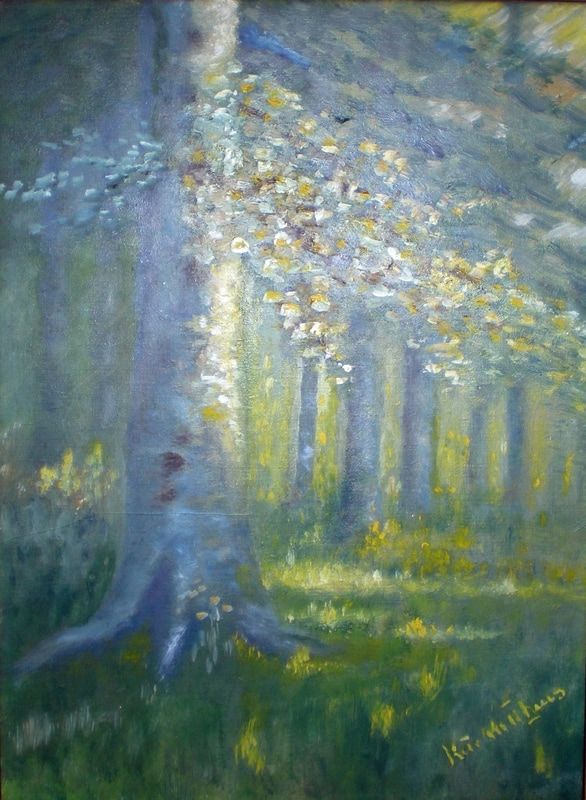 Kate Matthews' last oil painting, courtesy of Louise Herdt "Sis" Marker.
Kate Matthews' last oil painting, courtesy of Louise Herdt "Sis" Marker.
Though Kate was a talented photographer, she didn’t earn a living with her skills. “I think her family saw her as an eccentric, artistic person. They didn’t broadcast her photography talent. It was considered a whimsical thing,” observed her great-great-niece, the late Marjorie Fletcher Thompson of Peace Farm. “She actually has become much more famous since she died.”
Two years before her death, reporter Connie Courteau paid a visit to Clovercroft. Her story, "As The Years Pass By She Stays In Focus," appeared in the Courier-Journal Magazine on September 19, 1954. It covered Kate's photographic career and foray into oil painting as demand for her pictures declined:
"The old Matthews Place? It's the first house off the highway." No one has to ask twice in Pewee Valley to find the century-old mansion. The rambling frame house, hidden from the highway by towering maples and pines, is a famous place in the sleepy little Oldham County community.
As you walk up a wide gravel path inside a whitewashed plank fence, a turn-of-the-century atmosphere fairly leaps out from the wide front porch and from behind the high green shutters of Clovercroft.
It's a real life remnant, like a good bit of Pewee Valley, of the easy and pleasant life of 60 years ago. And the chief claim to fame of Clovercroft is one of its three residents, who can give you a glimpse of the Gay Nineties without half trying.
She is Miss Kate Matthews, who lives in the old family home with two nieces. And she can have her say about the past with pictures. Hundreds of them.
Back in the days when snapping pictures was the task for the accomplished amateur or the professional, Miss Kate, who celebrated her 84th birthday August 13, was winning honors for her five-by-eight dry plate exposures.
Perhaps the most widely seen of her pieces was the frontispiece portrait of the "Little Colonel," really Mrs. Albert Conrad Dick, of Louisville, for the first of the "Little Colonel books" written at Pewee Valley by Miss Kate's friend, Annie Fellows Johnston.
But that was nothing. Miss Kate has won so many prizes for more difficult and artistic photos, she can't remember them all.
The vigorous lady, whose dark hair has never grayed, started her photographic venture at age 16 with a bellows camera of the same type she uses today.
That was is 1886. She snapped her eight brothers and sisters, her friends, farm animals and landscapes, nearly all in the Pewee area, and by 1900 she was in as far as photographic societies and magazines were concerned.
She won first prizes in contests then the rage in national magazines, such as Youth's Companion, Illustrated American, Forward, The Brown Book of Boston, two in the Burr McIntosh Monthly, and others. If you're trying to recall when you last saw copies of these, remember they were current between 1898 and 1910.
She took firsts at the Kentucky State Fair as late as 1928, and at Chicago, Pittsburgh, Columbus. She also won in Louisville contests, and as she puts it, "took a prize every time The Courier-Journal had a contest."
There are notices posted in her scrapbook of $100 grand prizes -- mighty big money in those days (editor's note: the equivalent of $2,430.85 today) -- and demands from editors to let them know when she had other pictures they might publish. And publish they did, Cosmopolitan, Vogue, The Ladies Home Journal and Good Housekeeping, among many. ...
... After twelve of the "Little Colonel" books had gained Pewee Valley fame as the Land of the Little Colonel, Miss Kate photographed The Locust, home of the mythical Lloyd Sherman, and most of the real-life characters and sold them as postcards...
... Before long, Miss Kate's big blaze of photographic effort diminished to a steady fire. And once the days were over when brothers and sisters and friends were called upon to pose on the attic floor dressed as angels or to stand in the snow dressed in feathers and Indian blankets, life began moving at a much calmer pace....
... Since Miss Kate doesn't hold with candid cameras, her work today is greatly limited. There aren't many competitions for her to win these days, either...
... Since Miss Kate's market for her photographs is dwindling, she's taken to oil painting. Her new endeavor won her a blue ribbon last year at the Kentucky Woman's Club showing. A dozen landscapes and pastoral scenes hang on the wide landing of the hall stairs at Clovercroft.
Oil painting comes naturally, since she used oils to tint many of her early photographs...
Two years before her death, reporter Connie Courteau paid a visit to Clovercroft. Her story, "As The Years Pass By She Stays In Focus," appeared in the Courier-Journal Magazine on September 19, 1954. It covered Kate's photographic career and foray into oil painting as demand for her pictures declined:
"The old Matthews Place? It's the first house off the highway." No one has to ask twice in Pewee Valley to find the century-old mansion. The rambling frame house, hidden from the highway by towering maples and pines, is a famous place in the sleepy little Oldham County community.
As you walk up a wide gravel path inside a whitewashed plank fence, a turn-of-the-century atmosphere fairly leaps out from the wide front porch and from behind the high green shutters of Clovercroft.
It's a real life remnant, like a good bit of Pewee Valley, of the easy and pleasant life of 60 years ago. And the chief claim to fame of Clovercroft is one of its three residents, who can give you a glimpse of the Gay Nineties without half trying.
She is Miss Kate Matthews, who lives in the old family home with two nieces. And she can have her say about the past with pictures. Hundreds of them.
Back in the days when snapping pictures was the task for the accomplished amateur or the professional, Miss Kate, who celebrated her 84th birthday August 13, was winning honors for her five-by-eight dry plate exposures.
Perhaps the most widely seen of her pieces was the frontispiece portrait of the "Little Colonel," really Mrs. Albert Conrad Dick, of Louisville, for the first of the "Little Colonel books" written at Pewee Valley by Miss Kate's friend, Annie Fellows Johnston.
But that was nothing. Miss Kate has won so many prizes for more difficult and artistic photos, she can't remember them all.
The vigorous lady, whose dark hair has never grayed, started her photographic venture at age 16 with a bellows camera of the same type she uses today.
That was is 1886. She snapped her eight brothers and sisters, her friends, farm animals and landscapes, nearly all in the Pewee area, and by 1900 she was in as far as photographic societies and magazines were concerned.
She won first prizes in contests then the rage in national magazines, such as Youth's Companion, Illustrated American, Forward, The Brown Book of Boston, two in the Burr McIntosh Monthly, and others. If you're trying to recall when you last saw copies of these, remember they were current between 1898 and 1910.
She took firsts at the Kentucky State Fair as late as 1928, and at Chicago, Pittsburgh, Columbus. She also won in Louisville contests, and as she puts it, "took a prize every time The Courier-Journal had a contest."
There are notices posted in her scrapbook of $100 grand prizes -- mighty big money in those days (editor's note: the equivalent of $2,430.85 today) -- and demands from editors to let them know when she had other pictures they might publish. And publish they did, Cosmopolitan, Vogue, The Ladies Home Journal and Good Housekeeping, among many. ...
... After twelve of the "Little Colonel" books had gained Pewee Valley fame as the Land of the Little Colonel, Miss Kate photographed The Locust, home of the mythical Lloyd Sherman, and most of the real-life characters and sold them as postcards...
... Before long, Miss Kate's big blaze of photographic effort diminished to a steady fire. And once the days were over when brothers and sisters and friends were called upon to pose on the attic floor dressed as angels or to stand in the snow dressed in feathers and Indian blankets, life began moving at a much calmer pace....
... Since Miss Kate doesn't hold with candid cameras, her work today is greatly limited. There aren't many competitions for her to win these days, either...
... Since Miss Kate's market for her photographs is dwindling, she's taken to oil painting. Her new endeavor won her a blue ribbon last year at the Kentucky Woman's Club showing. A dozen landscapes and pastoral scenes hang on the wide landing of the hall stairs at Clovercroft.
Oil painting comes naturally, since she used oils to tint many of her early photographs...
Kate Matthews Oil and Pastel Paintings of Marjorie Fletcher Thompson as a Child, Courtesy of Angela Lasseigne
Oil Painting of Circus Scene by Kate Matthews, Courtesy of Angela Lasseigne
Death
Marjorie Thompson said that Kate was ill for about three years before her death. This "Valley Vignette" written by Florence Dickerson for the February 1975 Call of the Pewee provides a humorous anecdote about Kate's continuing battles with the croup or "leaf mold virus," as Thompson referred to it:
Although Kate Matthews lived eighty-six years, she was never a very robust person and frequently suffered from attacks of croup. The only remedy that seemed to give her any relief was a teaspoon of whiskey trickled down her throat.
Very early one morning sometime around the middle of the century Miss Kate awakened with the croup. Her sister, Mrs. Jesse Joy, who lived with her at "Clovercroft," could find no whiskey in the house. Aunt Jay, as she was known to the family, immediately telephoned their niece, Miss Lillian Fletcher.
Her cupboard was also bare, so she called her nephew, Matthews Fletcher. He found the necessary medicine and without bothering to dress jumped into the car and started up the lane. He found Miss Lillian waiting in her drive in her nightclothes and together they went to "Clovercroft."
Aunt Jay was attending Miss Kate and was not aware of Miss Lillian's and Mackey's arrival. The two sisters were always careful to secure the locks on all the windows and doors. Mackey quickly determined that it was futile to knock on the door, so he went in search of something to pry open a window. He found a knife used to cut asparagus and meanwhile, Miss Lillian circled the house looking for a means of entering.
Ernest Martin who was on his way to work for Miss Mary Johnston saw the commotion. He hurried on and when he arrived at "The Beeches" he said, "Call the police, Mr. Fletcher is chasin' Miss Lillian around the big house with a knife in one hand and a bottle of whiskey in the other and, Miss May, da ain't got no clothes on!"
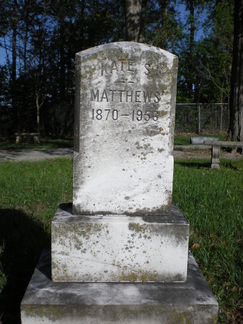
Kate Matthews died on July 5, 1956 in Room 8 at Pewee Valley Hospital. Her obituary ran in the next day's Courier-Journal:
Miss Matthews of Pewee Valley,
Photographer 70 Years, Dies at 86
She Had Won Many Prizes
Miss Kate Seston Matthews, who began her career as a photographer 70 years ago when photography and professional women were rarities, died at 6 a.m. yesterday at Pewee Valley Hospital. She was 86.
She brought to life with her camera the real-life counterparts of characters in “The Little Colonel” books. And she herself became a character, “Miss Katharine Marks,” in the series by Annie Fellows Johnston.
In May an exhibit of her photographs was on display in the Administration Building at the University of Louisville. The exhibit included such titles as “Sleep, My Pretty One,” “Going Home,” “The Shepherd Boy,” “Little Body Blue,” and “In The Studio.” It also included portraits of Little Colonel characters – Mom Beck, the old colonel, and Mrs. A. B. Dick as the Little Colonel.
‘Tells the Truth’
In a program accompanying the exhibit, Creighton Gilbert of the U. of L. art faculty wrote: “These photographs are not merely documents of a dated past…Miss Kate is a good photographer and therefore tells the truth.
“Therefore, along with the sentiments, the lilies and the sofas, we are presented in hard focus with the unpainted fence behind which the picturesque bonneted old woman stands, the plain kitchen table which is the cute little boy’s environment, and the touch of the macabre that we find in Victorian purity and Victorian plush.”
Started in 1886
Born in New Albany, Miss Kate lived most of her life in the sleepy little Oldham County community of Pewee Valley. She began taking pictures in 1886 when she was 16, using a bellows-type camera with photographic plates. She stuck with that kind of camera the rest of her life, resisting efforts of friends to convert to a candid camera. “I was the only one in the valley who had a camera in the old days,” she once recalled. She maintained a snapshot couldn’t produce the shading or detail of a time exposure.
In her early days as a photographer, Miss Kate won many prizes in contest of national magazines, such as Youth’s Companion, Illustrated American and Forward. She also had her work reproduced in Vogue, Good Housekeeping, Cosmopolitan and Ladies Home Companion.
Won Ad Contract
An 1895 article about her appeared in the Southern Magazine. She often took prizes at the Kentucky State Fair, and in exhibits at Chicago, Columbus and Pittsburgh.
One she won was an advertising contest sponsored by a soap company with a picture of a delicate young woman holding a rose and smelling a cake of soap. The caption read, “As Sweet as The Rose…”
Her photographs were used to illustrate “The Land of the Little Colonel,” a sort of postscript to the Little Colonel series written by Mrs. Johnston.
In recent years Miss Kate took up oil painting, and in 1953 won a blue ribbon for a painting in an exhibit sponsored by the Kentucky Federation of Women’s Clubs.
Producer Visited her
Miss Kate often played hostess to a distinguished visitor from Hollywood – producer Charles Brackett. His wife was a niece of Miss Matthews.
Miss Kate lived with two other nieces, Mrs. Fliss Guttenberger and Mrs. Elizabeth Feagan in her family home, Clovercroft. It is a 14-room home more than 100 years old.
Another survivor of Miss Kate is a grandnephew, Matthews Fletcher, Pewee Valley.
She had been ill about a month, and in the hospital since Sunday. The funeral will be at 4 p.m. today at Pewee Valley Presbyterian Church, where Miss Kate was Sunday school treasurer more than 50 years.
She will be buried in Pewee Cemetery.
Miss Matthews of Pewee Valley,
Photographer 70 Years, Dies at 86
She Had Won Many Prizes
Miss Kate Seston Matthews, who began her career as a photographer 70 years ago when photography and professional women were rarities, died at 6 a.m. yesterday at Pewee Valley Hospital. She was 86.
She brought to life with her camera the real-life counterparts of characters in “The Little Colonel” books. And she herself became a character, “Miss Katharine Marks,” in the series by Annie Fellows Johnston.
In May an exhibit of her photographs was on display in the Administration Building at the University of Louisville. The exhibit included such titles as “Sleep, My Pretty One,” “Going Home,” “The Shepherd Boy,” “Little Body Blue,” and “In The Studio.” It also included portraits of Little Colonel characters – Mom Beck, the old colonel, and Mrs. A. B. Dick as the Little Colonel.
‘Tells the Truth’
In a program accompanying the exhibit, Creighton Gilbert of the U. of L. art faculty wrote: “These photographs are not merely documents of a dated past…Miss Kate is a good photographer and therefore tells the truth.
“Therefore, along with the sentiments, the lilies and the sofas, we are presented in hard focus with the unpainted fence behind which the picturesque bonneted old woman stands, the plain kitchen table which is the cute little boy’s environment, and the touch of the macabre that we find in Victorian purity and Victorian plush.”
Started in 1886
Born in New Albany, Miss Kate lived most of her life in the sleepy little Oldham County community of Pewee Valley. She began taking pictures in 1886 when she was 16, using a bellows-type camera with photographic plates. She stuck with that kind of camera the rest of her life, resisting efforts of friends to convert to a candid camera. “I was the only one in the valley who had a camera in the old days,” she once recalled. She maintained a snapshot couldn’t produce the shading or detail of a time exposure.
In her early days as a photographer, Miss Kate won many prizes in contest of national magazines, such as Youth’s Companion, Illustrated American and Forward. She also had her work reproduced in Vogue, Good Housekeeping, Cosmopolitan and Ladies Home Companion.
Won Ad Contract
An 1895 article about her appeared in the Southern Magazine. She often took prizes at the Kentucky State Fair, and in exhibits at Chicago, Columbus and Pittsburgh.
One she won was an advertising contest sponsored by a soap company with a picture of a delicate young woman holding a rose and smelling a cake of soap. The caption read, “As Sweet as The Rose…”
Her photographs were used to illustrate “The Land of the Little Colonel,” a sort of postscript to the Little Colonel series written by Mrs. Johnston.
In recent years Miss Kate took up oil painting, and in 1953 won a blue ribbon for a painting in an exhibit sponsored by the Kentucky Federation of Women’s Clubs.
Producer Visited her
Miss Kate often played hostess to a distinguished visitor from Hollywood – producer Charles Brackett. His wife was a niece of Miss Matthews.
Miss Kate lived with two other nieces, Mrs. Fliss Guttenberger and Mrs. Elizabeth Feagan in her family home, Clovercroft. It is a 14-room home more than 100 years old.
Another survivor of Miss Kate is a grandnephew, Matthews Fletcher, Pewee Valley.
She had been ill about a month, and in the hospital since Sunday. The funeral will be at 4 p.m. today at Pewee Valley Presbyterian Church, where Miss Kate was Sunday school treasurer more than 50 years.
She will be buried in Pewee Cemetery.
Details about her funeral service ran in the July 12, 1956 Oldham Era:
... The body was prepared for burial at the M.A. Stoess & Sons Funeral Home, and funeral services were conducted Friday afternoon by Dr. George Edwards at the Pewee Valley Presbyterian Church...
... Active pallbearers were Messrs. Howard Orr, Wm. Herdt, Jr., Clayton E. Stoess, Thomas D. Murphy, L.W. Marker, Jr., and Charles Williams.''Honorary pallbearers were Messrs. Wm. Herdt, Sr., G.N. Summers, Frank Mahin, George Dyer, Jr., Carol Martin, Otis Chaudoin, John Gisiger, Peyton Hoge, Jr., Edward Ellis, William Hoge, Milton C. Stoess, Woodrow Moore, Wm. Berger, Jack Smith, Woodford Dulaney and Herbert Ross.
... The body was prepared for burial at the M.A. Stoess & Sons Funeral Home, and funeral services were conducted Friday afternoon by Dr. George Edwards at the Pewee Valley Presbyterian Church...
... Active pallbearers were Messrs. Howard Orr, Wm. Herdt, Jr., Clayton E. Stoess, Thomas D. Murphy, L.W. Marker, Jr., and Charles Williams.''Honorary pallbearers were Messrs. Wm. Herdt, Sr., G.N. Summers, Frank Mahin, George Dyer, Jr., Carol Martin, Otis Chaudoin, John Gisiger, Peyton Hoge, Jr., Edward Ellis, William Hoge, Milton C. Stoess, Woodrow Moore, Wm. Berger, Jack Smith, Woodford Dulaney and Herbert Ross.
Her last will and testament, transcribed below, was written on October 20, 1955 and witnessed by her two friends, Mary G. Johnston and Hallie Burge Jacob. Thanks to Oldham County Clerk Julie Barr for providing a copy.
I, Kate Seston Matthews, of Pewee Valley, Kentucky, do make this my last will and testament, hereby revoking any and all wills by me heretofore made.
Item I. I appoint my nephew, Matthews Fletcher, executor of my will.
Item II. I bequeath to my niece Mrs. Charles Brackett, of Los Angeles, California, any three of the oil paintings and any photograph album which she may choose, also Majolica dishes, the two marble statues, the two marble top tables, and the rugs she loaned to me.
Item III. I give to my niece, Mrs. Ferd Guttenberger, my house in Pewee Valley, Kentucky, known as “Clovercroft,” as well as the grounds on which it is located, together with all of the furnishings of every nature in and about the premises, with the exception of the items mentioned in Item II above.
Kate Matthews is buried in the Matthews family plot of Pewee Valley Cemetery with her parents and many of her siblings:
I, Kate Seston Matthews, of Pewee Valley, Kentucky, do make this my last will and testament, hereby revoking any and all wills by me heretofore made.
Item I. I appoint my nephew, Matthews Fletcher, executor of my will.
Item II. I bequeath to my niece Mrs. Charles Brackett, of Los Angeles, California, any three of the oil paintings and any photograph album which she may choose, also Majolica dishes, the two marble statues, the two marble top tables, and the rugs she loaned to me.
Item III. I give to my niece, Mrs. Ferd Guttenberger, my house in Pewee Valley, Kentucky, known as “Clovercroft,” as well as the grounds on which it is located, together with all of the furnishings of every nature in and about the premises, with the exception of the items mentioned in Item II above.
Kate Matthews is buried in the Matthews family plot of Pewee Valley Cemetery with her parents and many of her siblings:
- Lucien George Matthews (Father)
1825-1896 - Charlotta Ann Matthews (Mother)
1832-1911 - William John Matthews (Brother)
1856-1927 - Harriet Wood Matthews (Sister-in-Law; Married to William)
1856-1950 - Charlotta Matthews Osborn (Sister)
1862-1935 - Florence Matthews (Sister)
April 23, 1864- September 4, 1946 - Jesse Matthews Joy (Sister)
May 5, 1868- September 12, 1950 - Kate Matthews
August 13, 1870- July 5, 1956 - Edward Hubbert Matthews (Brother)
March 18, 1873- June 6, 1932
Program from the Kate Matthews and the Little Colonel Exhibition at the University of Louisville in 1963, Courtesy Ed Shadburn
Related Links

